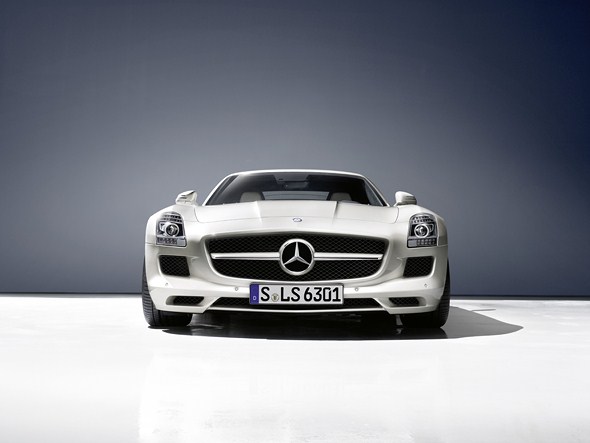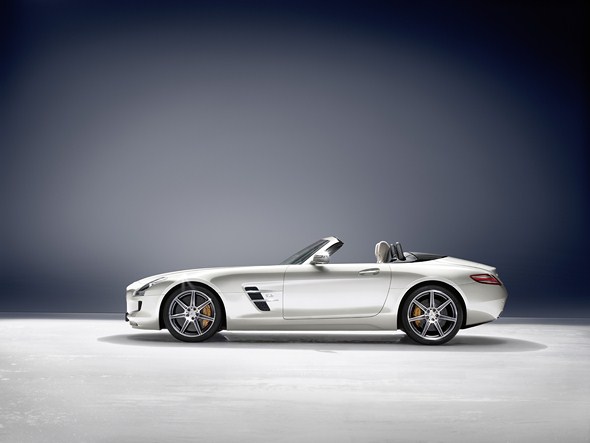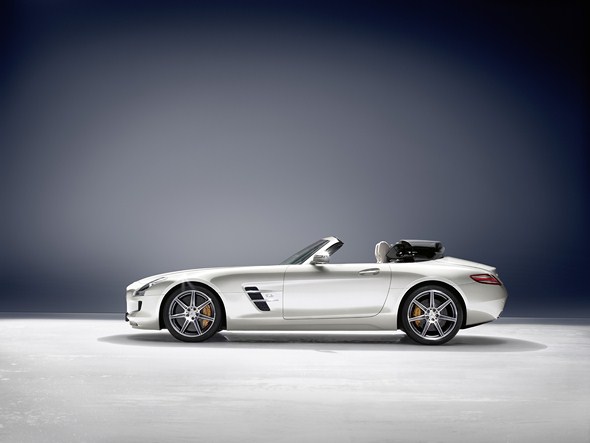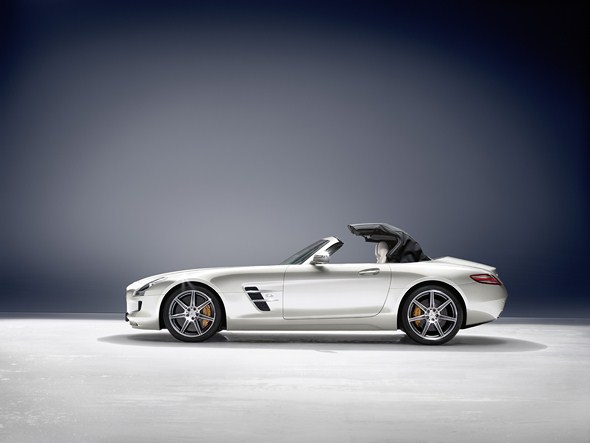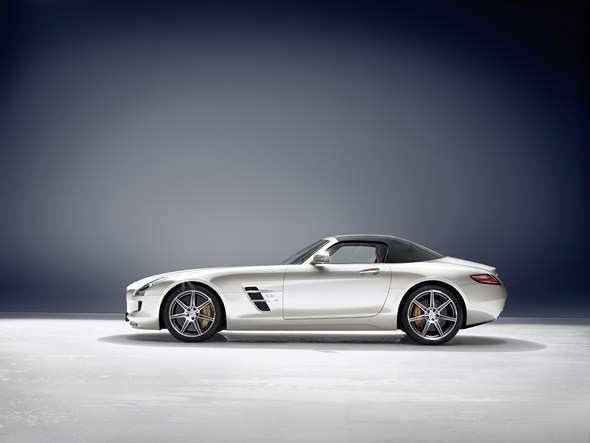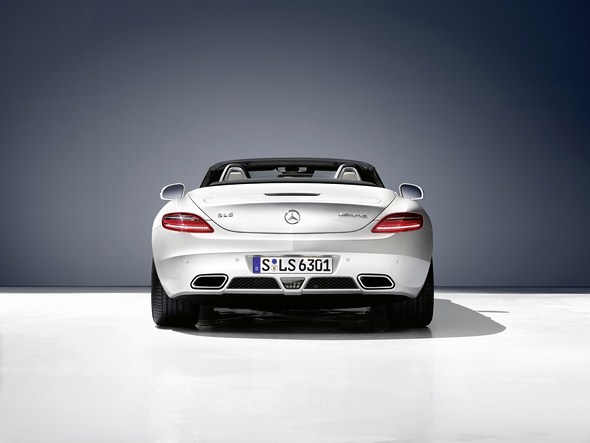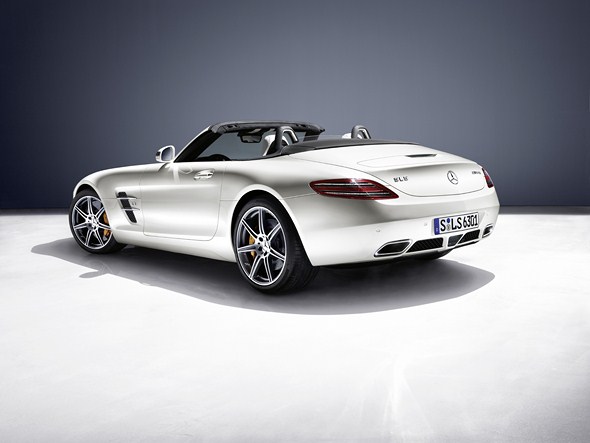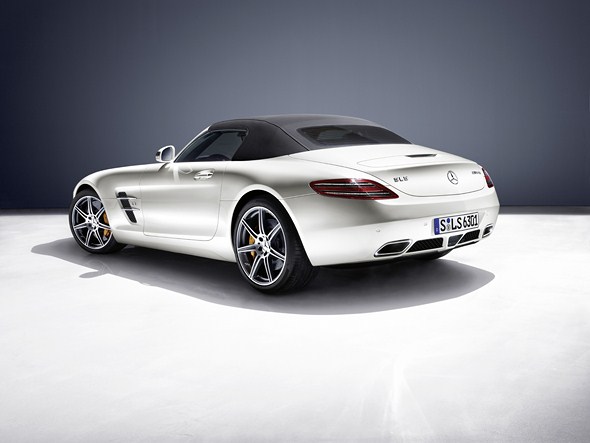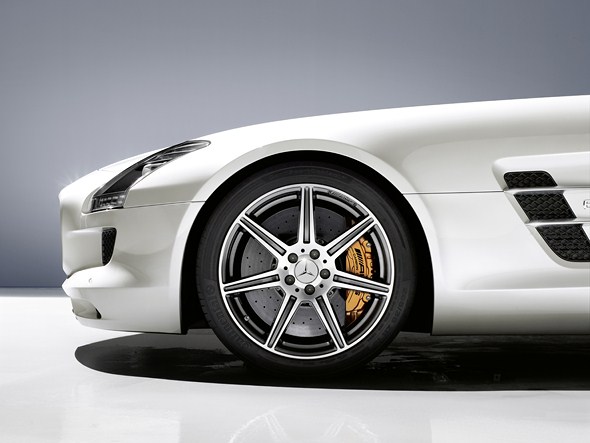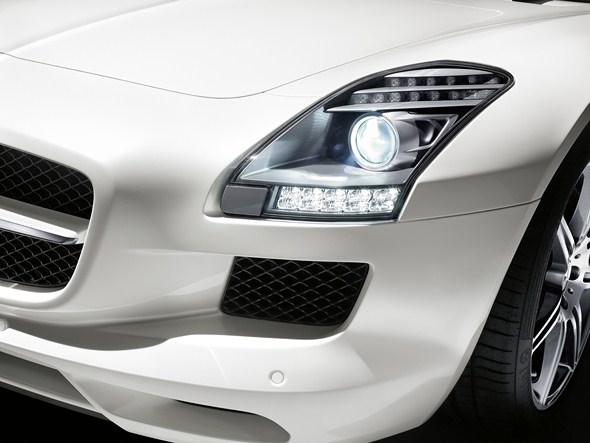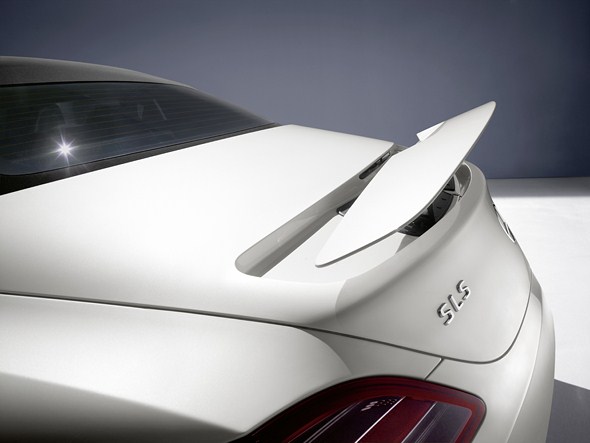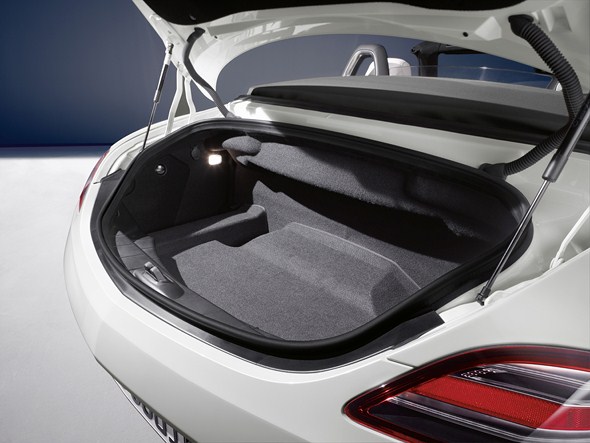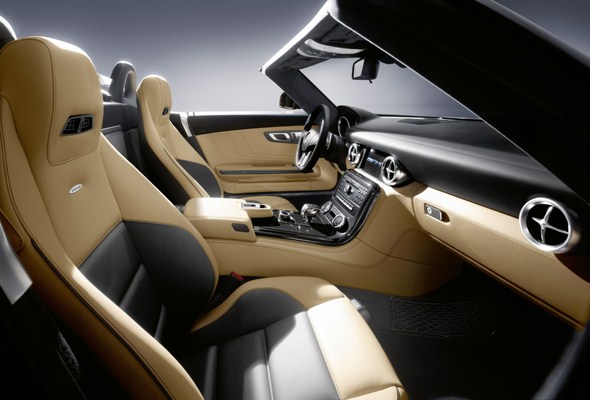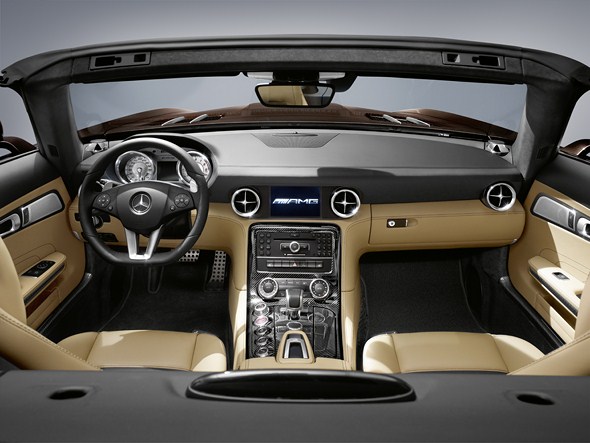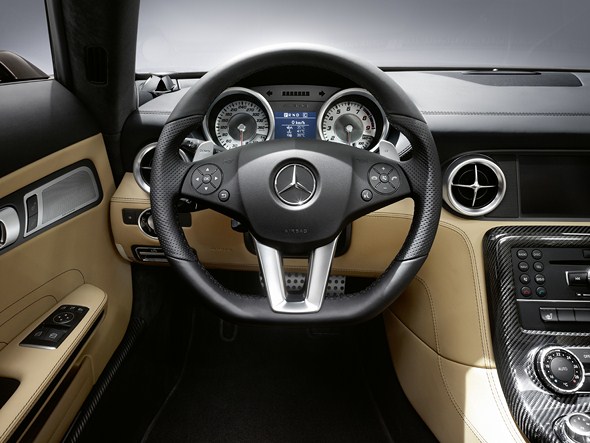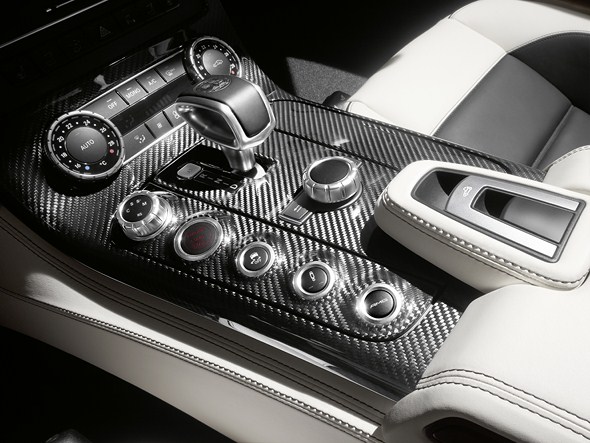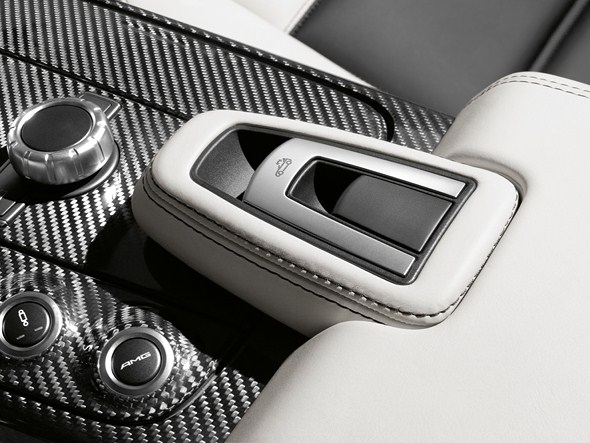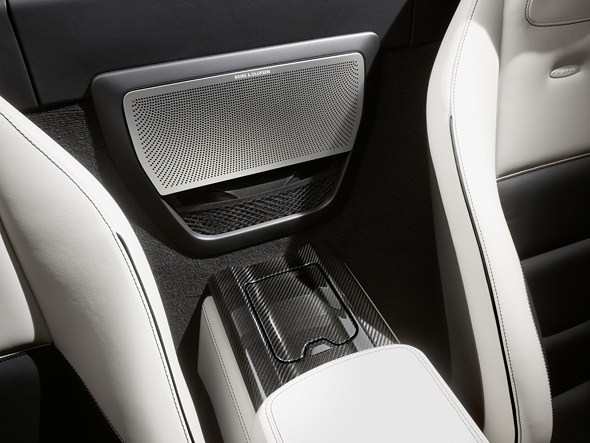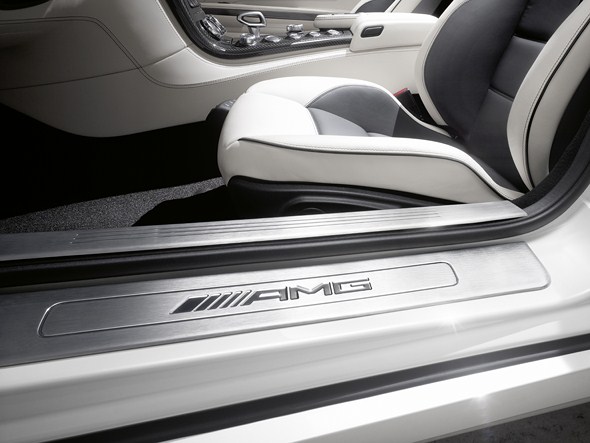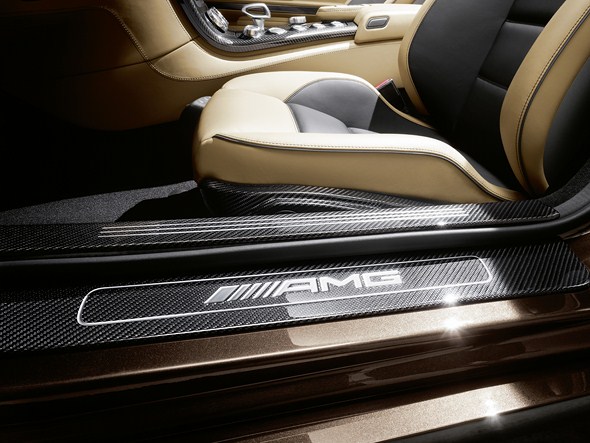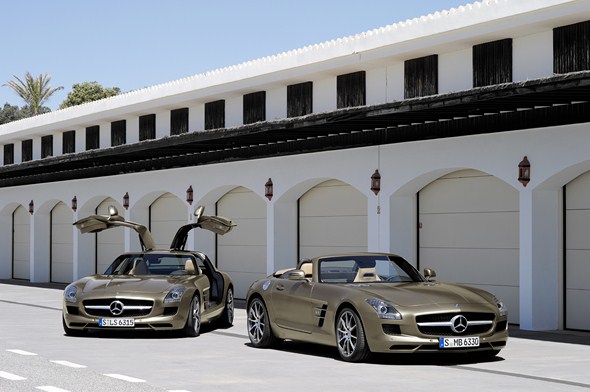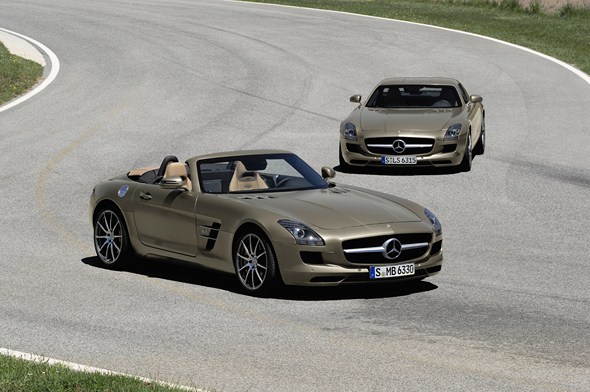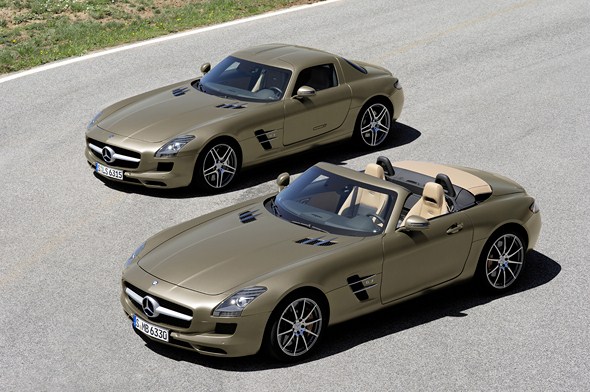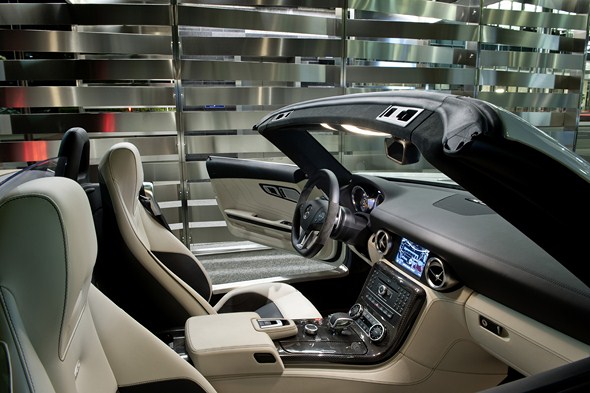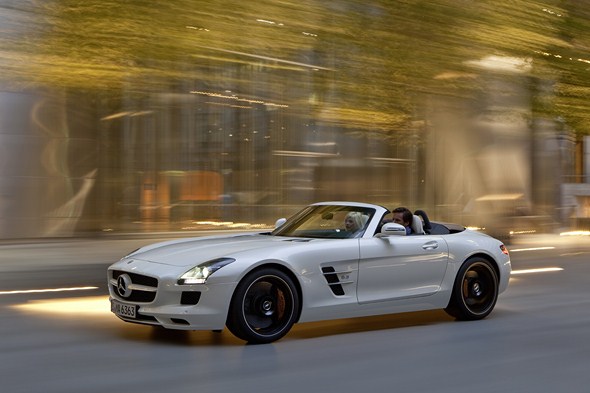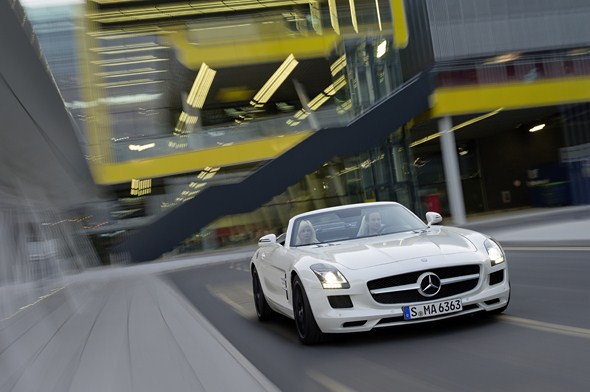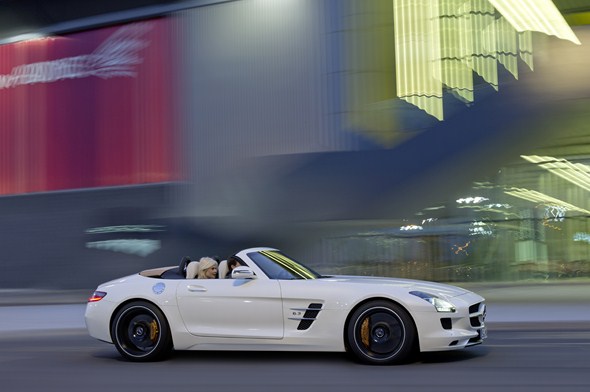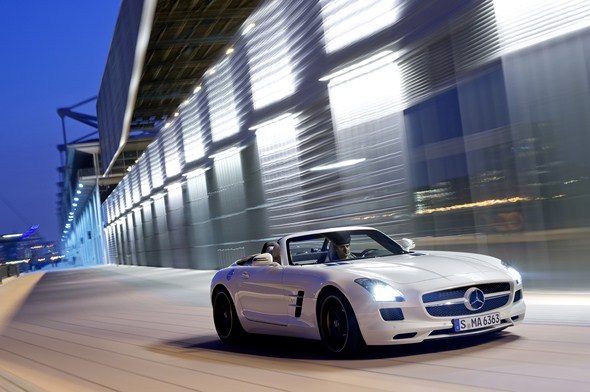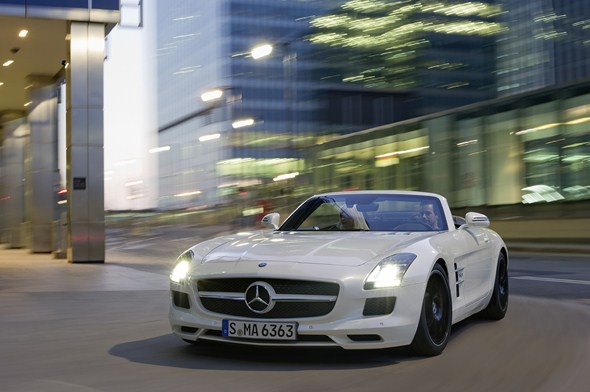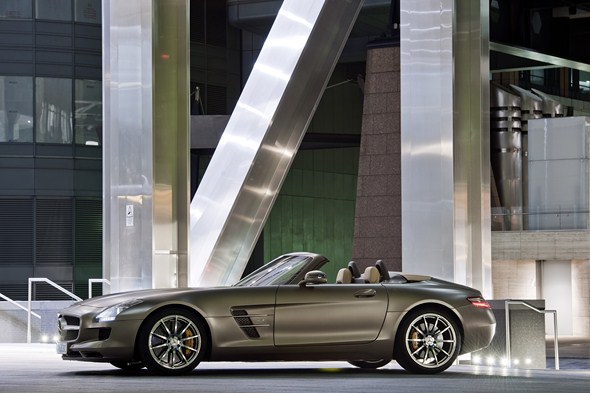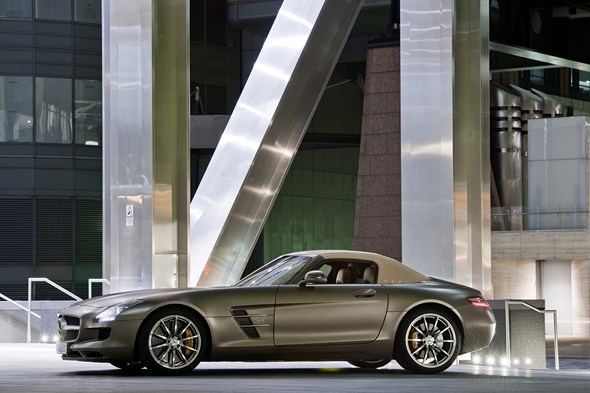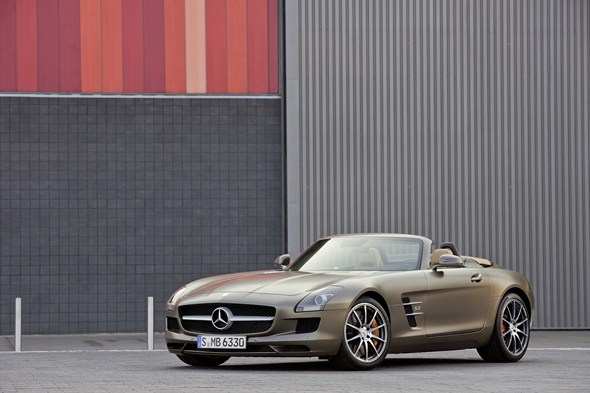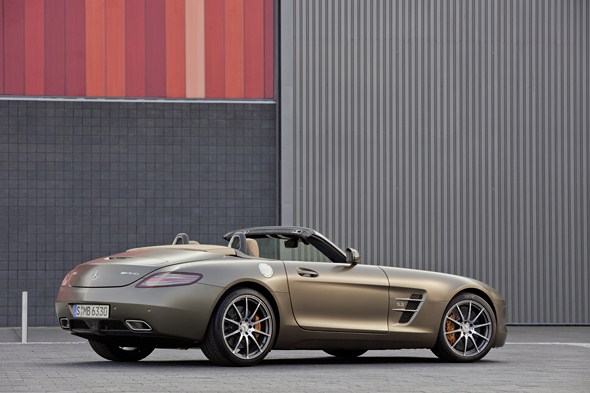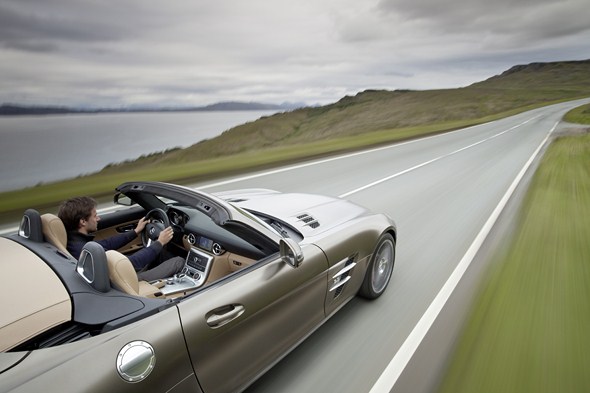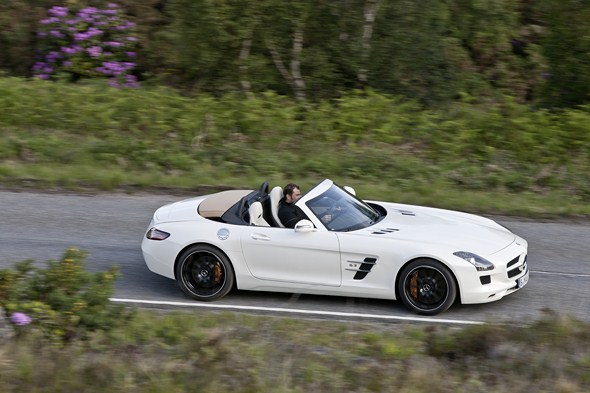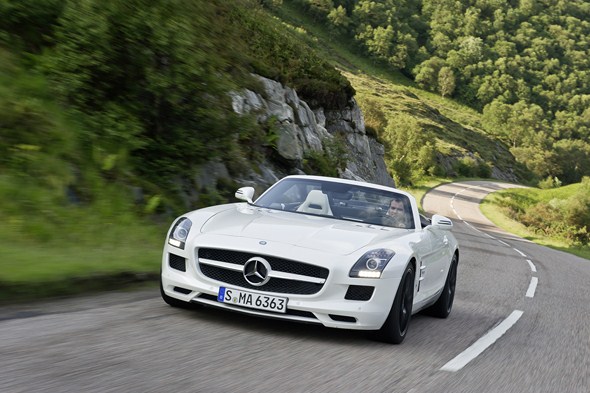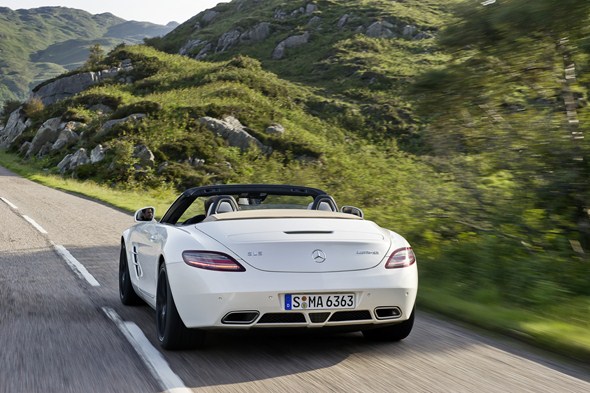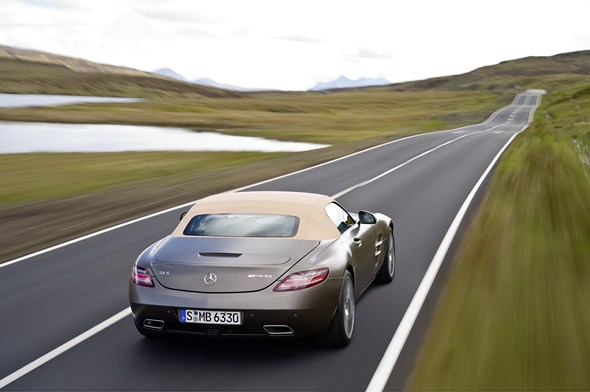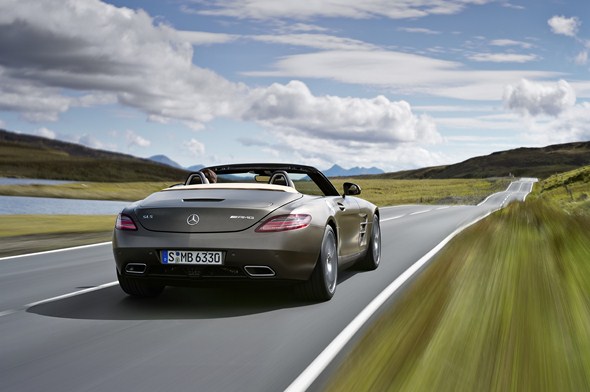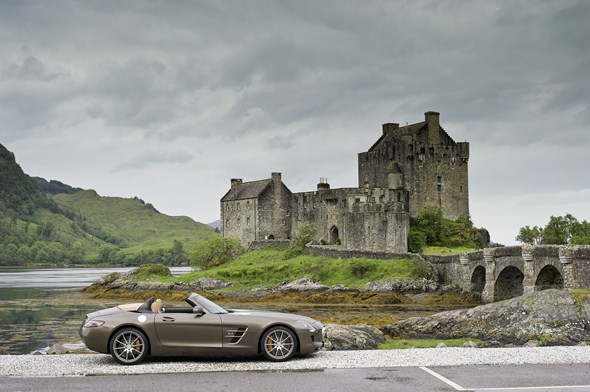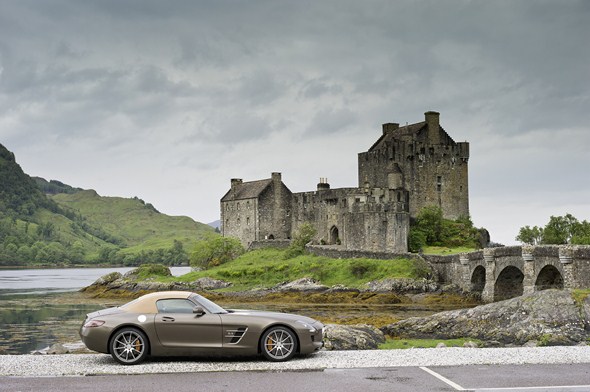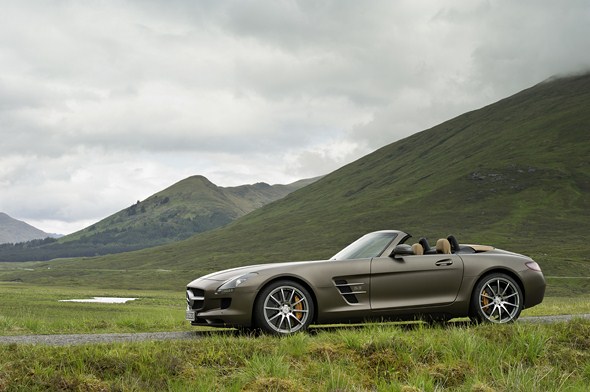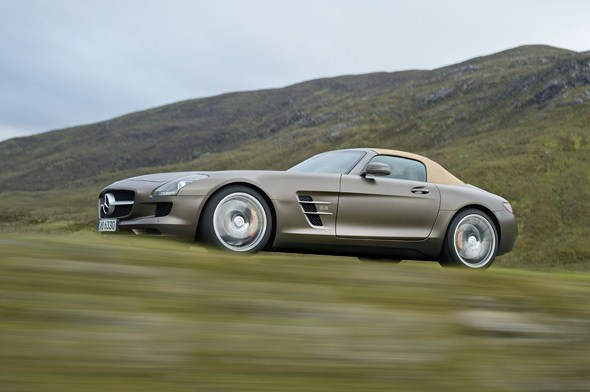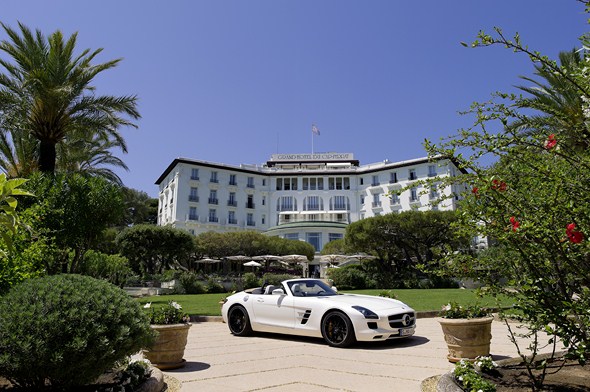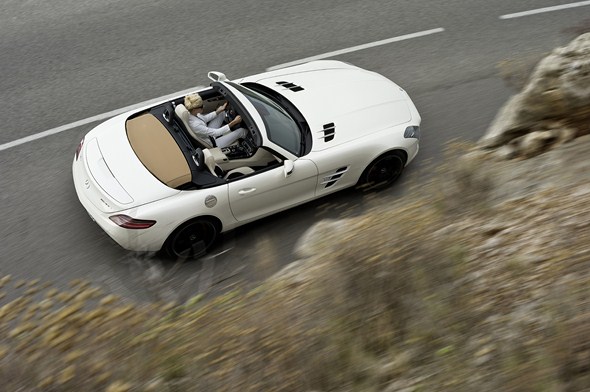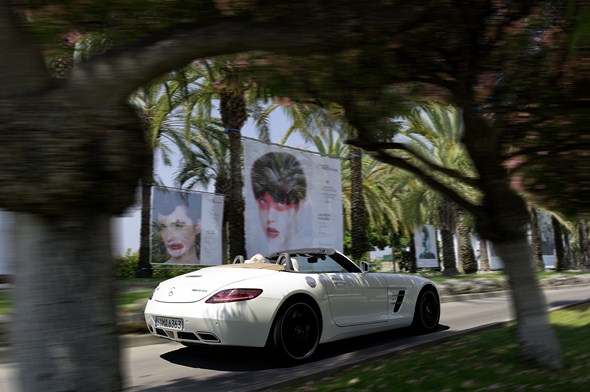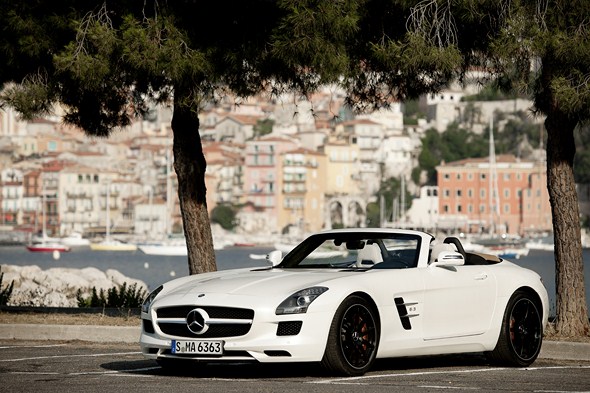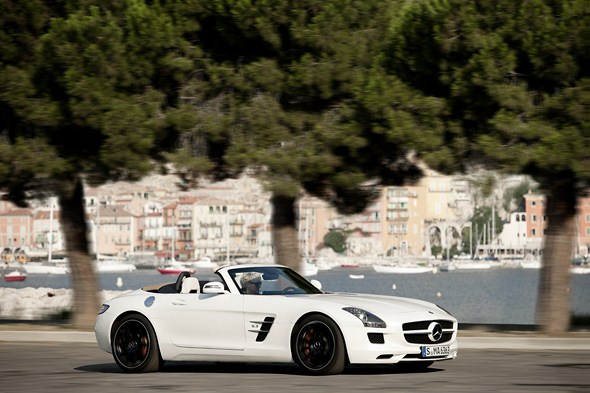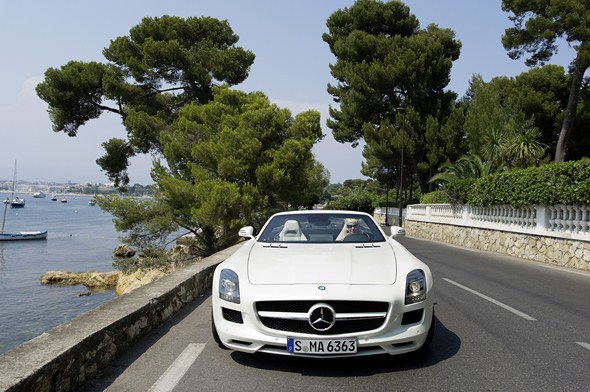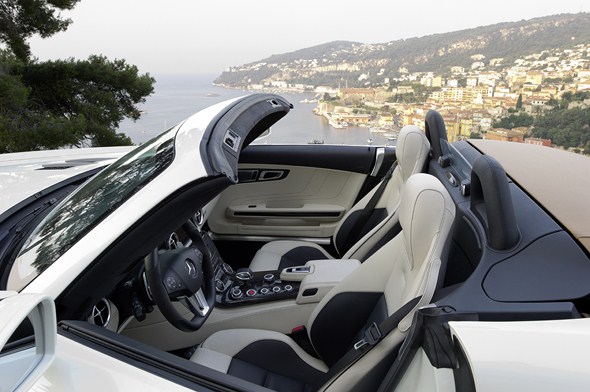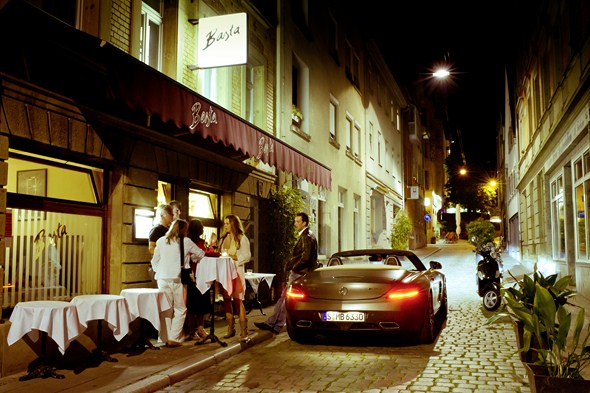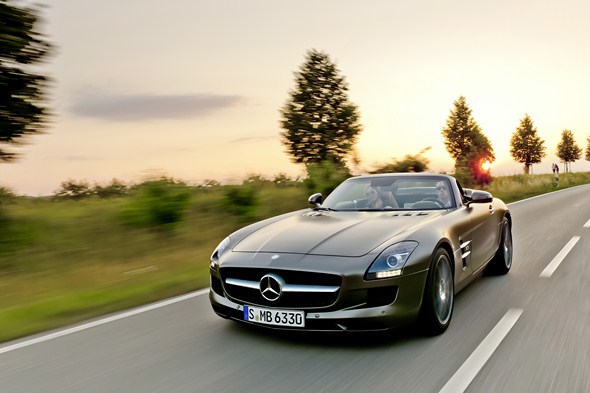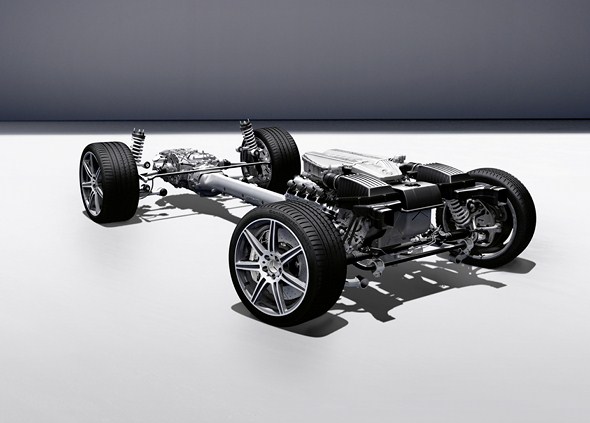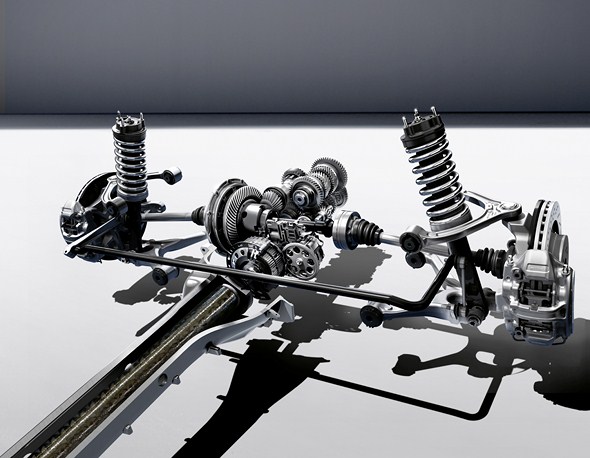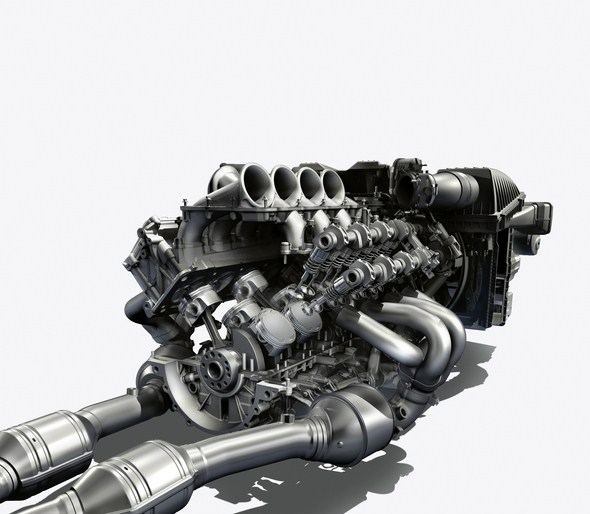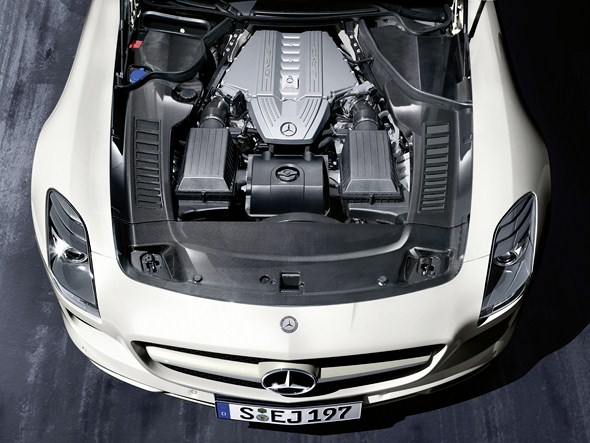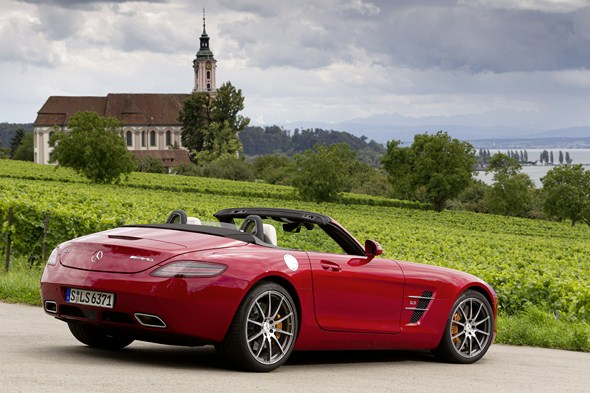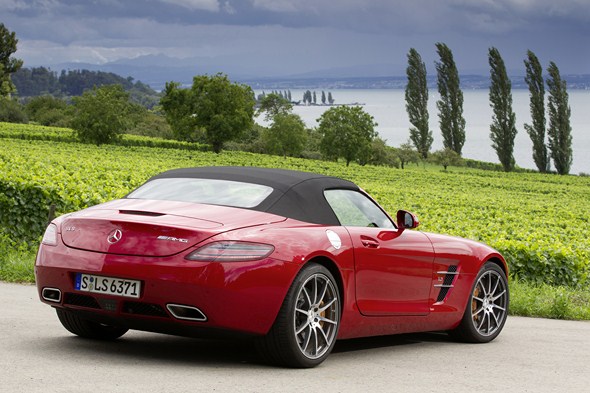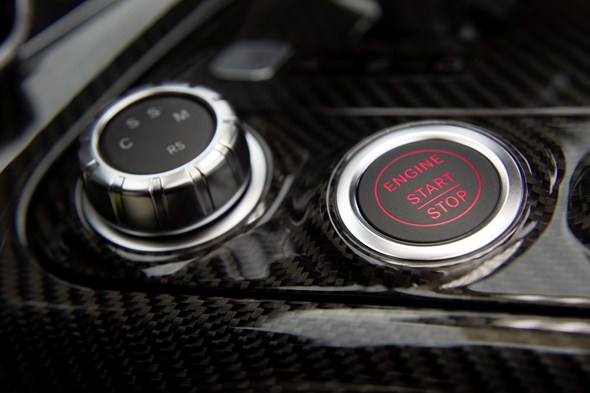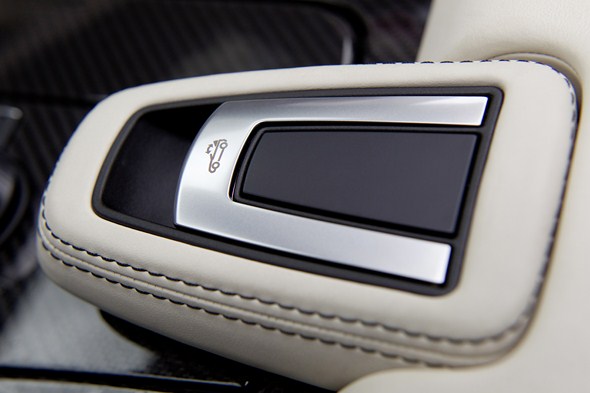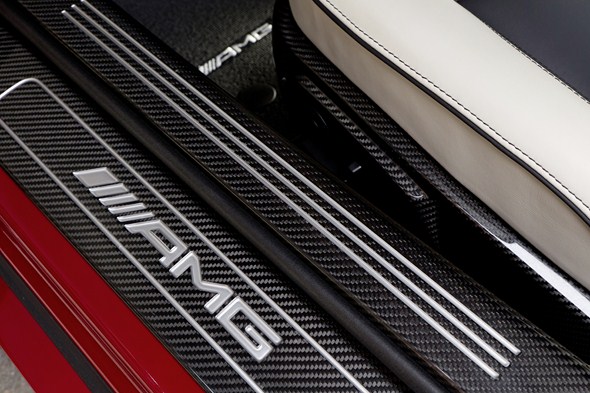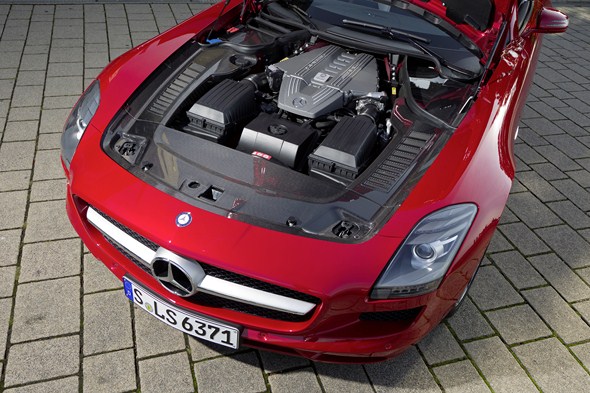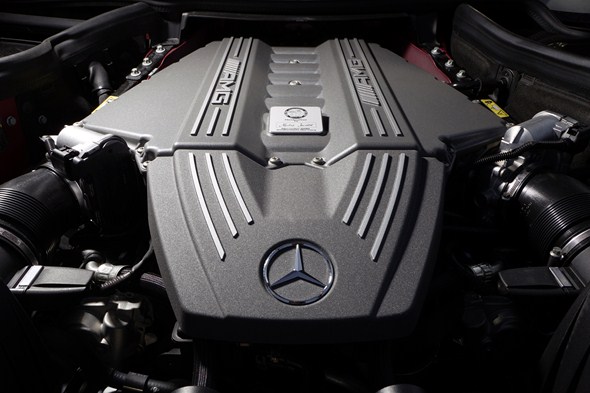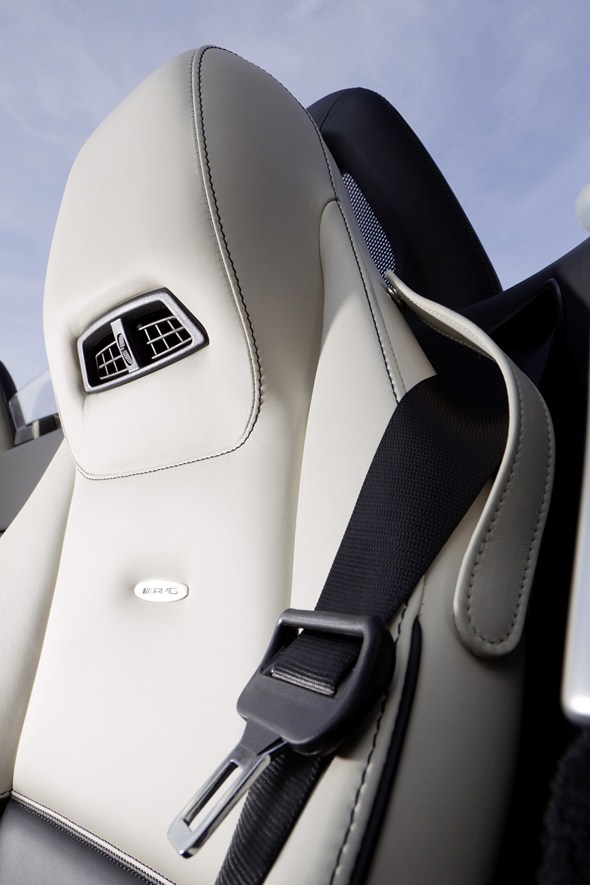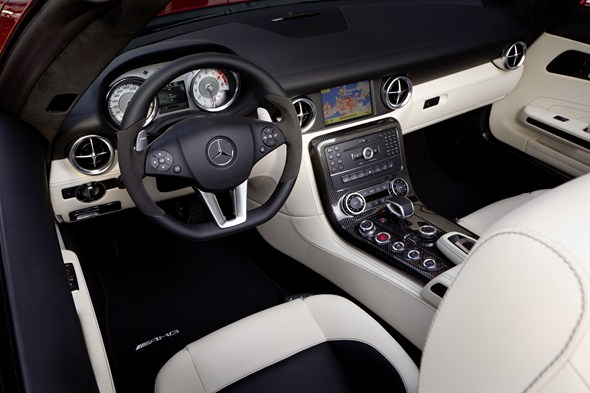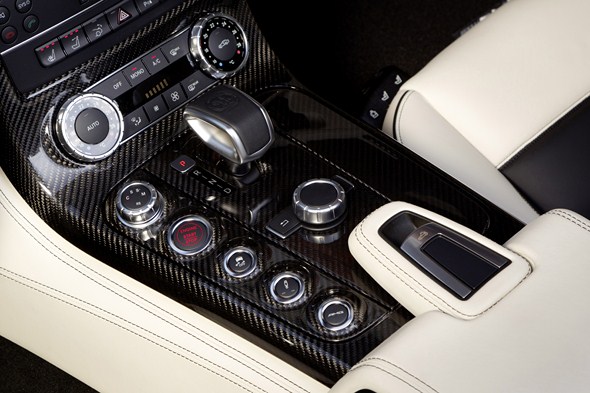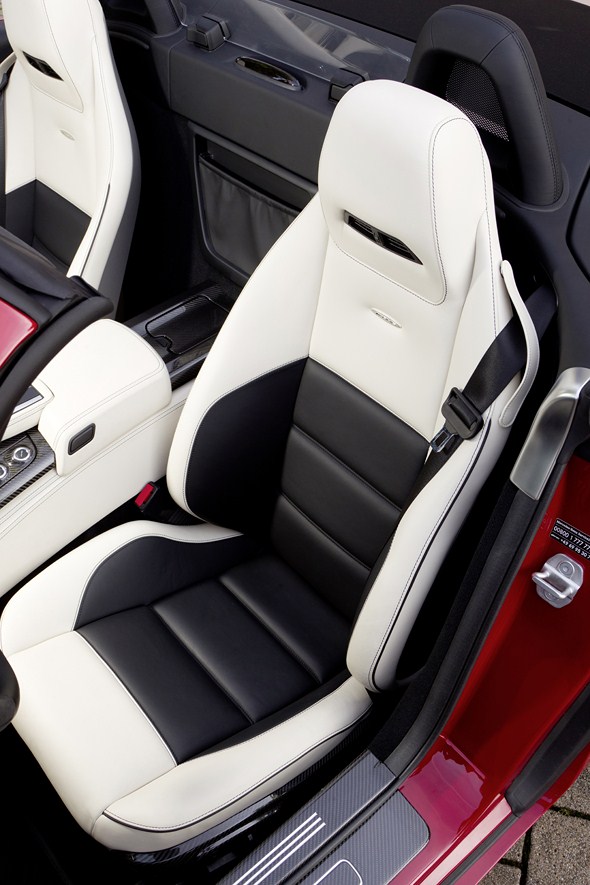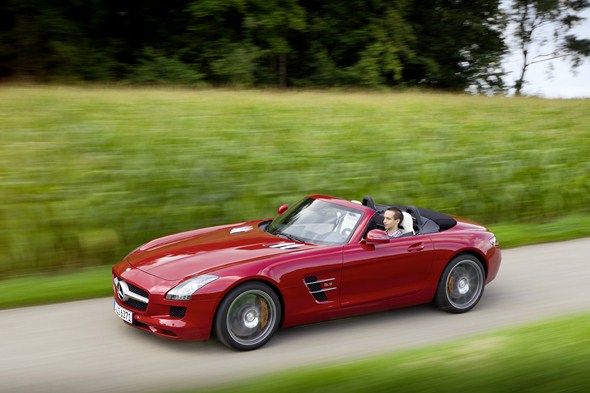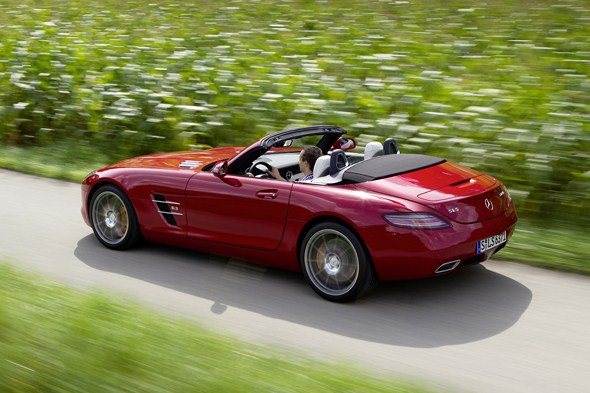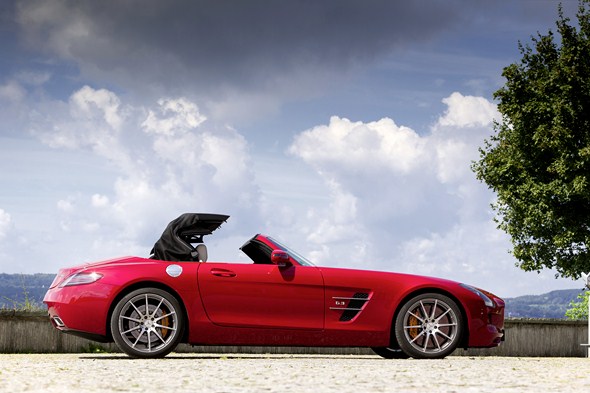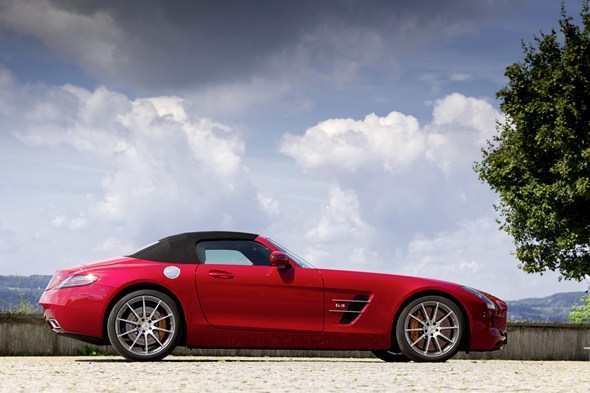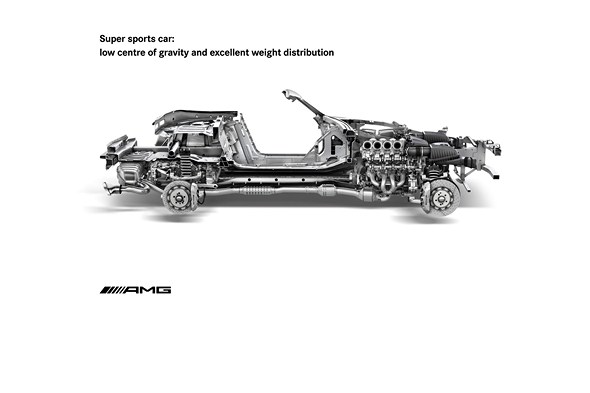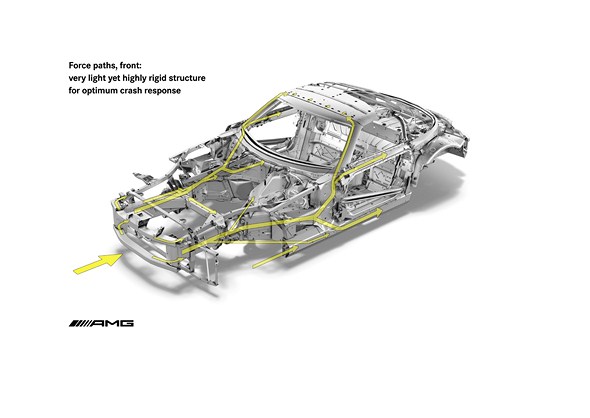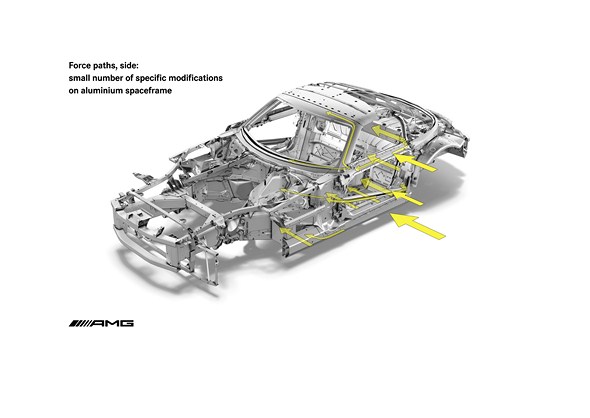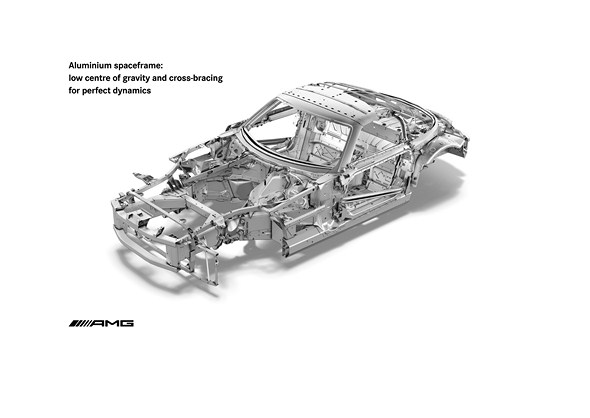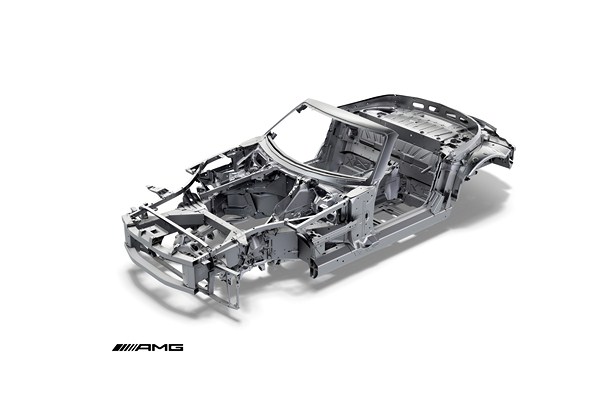Second AMG dream car after the gullwing model

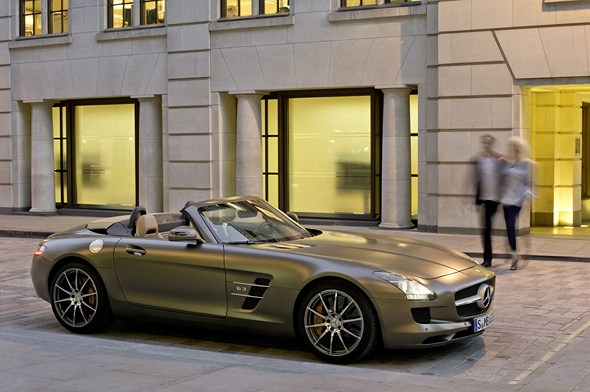
The SLS AMG Roadster: open-top sensuality
- Purist: breathtaking design
- Uncompromising: lightweight construction and motor sports technology
- Outstanding: fulminating performance and open-top driving pleasure
- Powerful: eight-cylinder engine developing 420 kW (571 hp)
- Variable: new AMG RIDE CONTROL sports suspension
- World first: AMG Performance Media with internet connectivity
AMG, the high-performance brand within Mercedes-Benz Cars, is presenting a new dream car: the SLS AMG Roadster. Two years after the sensational launch of the gullwing model at the 2009 International Motor Show (IAA), the open-top variant of this super sports car is now set to follow.
The technological highlights of the SLS AMG Roadster read like an A-B-C of modern sports car engineering: the combination of an aluminium spaceframe body, an AMG 6.3-litre V8 front-mid engine with dry sump lubrication developing a peak output of 420 kW (571 hp) and 650 newton metres of torque, a seven-speed dual clutch transmission in a transaxle arrangement and a sports suspension with aluminium double wishbones is guaranteed to make the hearts of sports car enthusiasts beat faster – while ensuring outstanding driving dynamics and roadster motoring pleasure.
The compact fabric soft top of the SLS AMG Roadster opens and closes in just eleven seconds, and can be operated on the move at speeds up to 50 km/h.
The new AMG RIDE CONTROL sports suspension with electronically controlled damping is available as an attractive optional extra. It enables the damping characteristics to be modified at the touch of a button. Using the AMG DRIVE UNIT, the driver of the SLS AMG Roadster is therefore able to choose his own suspension setup. Three modes are available: “Comfort”, “Sport” and “Sport plus”.
“AMG Performance Media” is a unique new feature: this innovative multimedia system inspired by motorsport offers an unrivalled combination of numerous telemetric displays such as lateral and linear acceleration, various engine data and lap times on a racetrack, and also features high-speed mobile internet access.
Dr Dieter Zetsche, Chairman of the Board of Management of Daimler AG and CEO of Mercedes-Benz Cars: “The SLS Roadster is a super sports car, cruiser and highly desirable dream-car all in one. It its distinctive way, it continues
the succession of iconic and exciting sports cars from Mercedes-Benz.”
Ola Källenius, Chairman of Mercedes-AMG GmbH: “Systematic lightweight construction, outstanding performance and a breathtaking design combined with sensuous open-air driving pleasure – the new SLS AMG Roadster perfectly embodies the AMG philosophy of German engineering and craftsmanship. The gullwing model has already thrilled sports car fans all over the world, and now the open-top version is bound to cause a sensation.”
Key data at a glance:
| Mercedes-Benz SLS AMG Roadster | |
| Cylinder arrangement | V8 |
| Valves per cylinder | 4 |
| Displacement | 6208 cc |
| Bore x stroke | 102.2 x 94.6 mm |
| Compression ratio | 11.3 : 1 |
| Output | 420 kW (571 hp) at 6800 rpm |
| Max. torque | 650 Nm at 4750 rpm |
| Fuel consumption NEDC combined | 13.2 l/100 km |
| CO2 emissions | 308 g/km |
| Acceleration 0 – 100 km/h | 3.8 s |
| Top speed | 317 km/h* |
* electronically limited
Purist roadster design with perfect proportions
The new Roadster adds a second exciting dream car to the AMG model family. Head of Design at Mercedes-Benz, Gorden Wagener: “As in the gullwing model, the purist, athletic design immediately captures the attention. Whether with the roof open or closed, the SLS AMG Roadster is an impressive visual delight!” The perfect proportions are particularly memorable: a long bonnet, the greenhouse positioned well to the rear and a short rear end. Plus the automatically extending rear aerofoil, long wheelbase, wide track and short overhangs – in short, the open-top SLS AMG likewise exudes effortless dynamism and an authentic charisma. The pronounced shoulder sections are reminiscent of tensed muscles, and suggest sheer power in combination with the large wheels in size 265/35 ZR 19 (front) and 295/30 ZR 20 (rear). The attractive metallic paint finish AMG Sepang brown and weight-optimised forged wheels in a 10-spoke design, painted in matt black with a high-sheen rim flange, are available as new optional extras.
Features reminiscent of the 300 SL Roadster, the classic dream-car from the 1950s, include not only the wide radiator grille with its large Mercedes star and the wing-shaped cross-fin, but also the fins on the bonnet and on the vehicle flanks. Like the SLS AMG Roadster, the 300 SL Roadster appeared slightly later than the original gullwing 300 SL, but unlike in the former
case both AMG dream cars are available at the same time.
Interior atmosphere as in an aircraft cockpit
The interior continues the breathtaking design idiom of the exterior, and awakens associations with an aircraft cockpit: prominent stylistic features include the dashboard in the shape of a wing section and the air vents with adjustable, cruciform nozzles reminiscent of jet engines. The extended centre console of matt, solid metal and the new E-SELECT lever in the shape of an aircraft’s thrust control are also design features adopted from the world of aviation. Another discreet, fine detail is the embossed AMG emblem on the leather-lined selector lever.
The AMG DRIVE UNIT – which like numerous other interior features is available in real carbon-fibre – is the central control unit in the centre console: it allows the driver to choose a personal vehicle setup, including adjustment of the AMG RIDE CONTROL sports suspension (optional). The AMG Performance steering wheel with its high-grade nappa leather lining and flattened lower rim section allows perfect vehicle control. The shift paddles and lower steering wheel bezel are of solid metal.
Fully automatic, weight-optimised soft top
The sensual experience in the SLS AMG Roadster is enhanced further when
the soft top is open, and the powerful, naturally aspirated eight-cylinder engine with 420 kW (571 hp) and 650 newton metres of torque asserts itself and makes the heart beat faster with its typical AMG eight-cylinder sound. The fabric soft top can be opened and closed while on the move at up to 50 km/h; the fully automatic opening/closing process takes only eleven seconds. The driver only needs to operate the roof control unit conveniently integrated at the front of the centre armrest. When open, the soft top is space-savingly deposited behind the seats in a folded Z-configuration. Three soft top colours – black, red and beige – are available to suit the nine exterior and six interior colours.
The three-layered fabric soft top is a weight-optimised magnesium /steel/ aluminium construction, and contributes greatly to the car’s low centre of gravity. The soft top has a seamlessly bonded rear window of heated single-layer safety glass. The flush, gap-free transition between the outer roof skin and the rear window keeps wind noise at a low level. A continuous, flexible water pocket running under the soft top catches rainwater and directs it to
the underbody via two apertures on each side. The boot capacity is 173 litres with the roof either open or closed, and therefore roughly equal to that of the SLS AMG Coupé (176 litres).
Outstanding material quality and standard of finish
The finest leather, matt-finished solid metal or optional, real carbon-fibre trim create an exclusive ambience and correspond with the authentic feel of the cockpit. Precisely executed decorative and contrasting stitching enhances the visual impression, heightens the hand-crafted look and reflects the attention
to detail which is the hallmark of Mercedes design.
The standard appointments of the SLS AMG Roadster include black designo leather, AMG sports seats with heating, a slot-in draught-stop, COMAND APS with DVD player, anti-theft alarm system with tow-away protection and interior monitoring, THERMOTRONIC luxury automatic climate control and the KEYLESS-GO starting function. The optionally available AIRSCARF® system exclusive to Mercedes-Benz acts like an invisible scarf warming the head and neck areas of the occupants. It is integrated into the backrests of the AMG sports seats, and blows warm air from vents in the head restraints. Leather-lined roll-over bars with integrated mesh are available in conjunction with
the optional designo Exclusive leather to reduce turbulence in the cockpit. Ambient lighting is integrated into the optionally available, electrically folding exterior mirrors.
Single-tone or two-tone designo leather in espresso brown is available as a new interior colour – this dark shade of brown perfectly matches the new metallic paint finish AMG Sepang brown.
AMG Performance Media and Bang & Olufsen as optional highlights
Another optional highlight is available in addition to the Bang & Olufsen BeoSound AMG surround sound system, which provides exclusive musical enjoyment at the highest level: AMG Performance Media. In an unprecedented way, this system inspired by motor racing combines numerous telemetric displays such as engine data, lateral and linear acceleration and lap times on a racetrack, as well as providing high-speed mobile internet access. AMG Performance Media is activated by pressing the AMG key in the AMG DRIVE UNIT, and operated using the COMAND Controller. Key functions at a glance:
- Real-time display of engine oil, coolant and transmission fluid temperature
- Real-time display of engine output, torque and accelerator position
- Real-time display of individual tyre pressures
- Real-time display of acceleration time from 0-100 km/h (alternatively: quarter-mile)
- Real-time display of lateral and linear acceleration combined with braking performance and accelerator position, including memory function
- Recording of individual lap times on a closed-off racetrack, with sector times and memory function
- Integration of Drive Unit functions to save setup data to memory and initiate RACE START
The different functions of AMG Performance Media are shown by the colour display integrated into the dashboard. Three displays are shown at any one time, with the most important information positioned in the centre. Digitally simulated dial instruments with red needles ensure outstanding legibility.
High-speed mobile internet access
AMG Performance Media also provides high-speed mobile internet access: when the car is stationary, the driver and passenger are able to surf the web, download and install apps, and send or receive emails – this unrivalled system has functions comparable to those of a PC, notebook or smartphone. AMG Performance Media uses the widespread, high-performance Android operating system. This exclusive new development will also be installed in other AMG high-performance cars in the future.
Specifically reinforced aluminium spaceframe, low DIN kerb weight
In addition to a high level of occupant comfort, the key factor for driving pleasure in the new SLS AMG Roadster is of course the outstanding performance. The basis for this is the innovative body design: the chassis and body are of aluminium, a design combining intelligent lightweight construction with high strength. With a DIN kerb weight of 1660 kilograms, the Roadster is only 40 kilograms heavier than the Coupé. The result is a remarkable power-to-weight ratio of 2.9 kilograms per hp.
In order to achieve handling dynamics identical to those of the Coupé, despite the lack of a fixed roof, the SLS AMG Roadster has features specifically designed to rigidify the bodyshell, for example side skirts with greater wall thicknesses and more chambers. The dashboard cross-member is supported against the windscreen frame and centre tunnel by additional struts, and a curved strut between the soft top and the tank reinforces the rear axle. To maintain stability despite the omission of the Coupé roof and gullwing doors, the open-top SLS AMG has a reinforcing cross-member behind the seats to support the fixed roll-over protection system. This also accommodates the 250 watt subwoofer of the optional Bang & Olufsen BeoSound AMG high-end sound system.
All this prevents unwanted vibrations right from the start, and makes it unnecessary to use the additional, weight-increasing vibration dampers that are often found in open-top sports cars. The weight-optimised aluminium spaceframe weighs 243 kilograms, tipping the scales at just two kilograms more than the gullwing model.
Intelligent material mix and low centre of gravity
50 percent of the intelligently designed, weight-optimised aluminium spaceframe is of aluminium sections, 26 percent of sheet aluminium,
18 percent of cast aluminium and 6 percent of steel. For maximum occupant safety, ultra-high-strength, heat-formed steel is used in the A-pillars.
The entire vehicle concept has been designed to achieve the lowest possible centre of gravity. This applies both to the low connection of the powertrain
and axles, as well as to the arrangement of the rigidity-conducive bodyshell structure, which has been kept as low as possible. Examples include the rigid flexural and torsional connections between the front and rear section and the safety passenger cell, which have been realised consistently using force paths that are as low as possible. This results not only in a low centre of gravity but also in a harmonious and therefore efficient force path in the vehicle structure.
Passive safety at a high level
The aluminium spaceframe provides the basis for outstanding passive safety. The extensive safety features include the fixed roll-over protection system, three-point seat belts with belt tensioners and belt force limiters, and eight airbags: adaptive front airbags and kneebags, two seat-integrated sidebags
and two windowbags deploying from the door beltlines.
The optionally available Blind Spot Assist helps the driver with a visual warning symbol and acoustic alert if the danger of a collision with another vehicle is detected when changing lanes.
Powerful AMG 6.3-litre V8 engine with 420 kW (571 hp)
The SLS AMG Roadster has the same, muscular engine as the gullwing model. The 6.3-litre V8 with a peak output of 420 kW (571 hp) at 6800 rpm makes
the open-top SLS one of the most powerful sports cars in its segment. Its power-to-weight ratio is 2.9 kg/hp. This naturally aspirated engine generates its maximum torque of 650 newton metres at 4750 rpm. The open-top SLS AMG accelerates from zero to 100 km/h in 3.8 seconds, reaches 200 km/h in 11.3 seconds and has a top speed of 317 km/h (electronically limited) – which means that the Roadster has a performance comparable to the gullwing variant.
The high-revving V8 engine with a cubic capacity of 6208 cc has the typical characteristics of powerful racing engines. It responds immediately to accelerator movements and is extraordinarily willing. The use of a dry sump lubrication system makes for a considerably lower installed position in the vehicle. The resulting, lower centre of gravity allows high lateral acceleration and ensures thrilling driving dynamics.
Achievement of demanding fuel consumption targets
Despite its uncompromisingly sporty character, very ambitious fuel consumption targets have been met. Like the gullwing variant, the SLS AMG Roadster consumes 13.2 litres per 100 kilometres (NEDC combined), corresponding to CO2 emissions of 308 grams per kilometre. Efficiency-enhancing measures include the familiar AMG-exclusive, friction-optimised NANOSLIDE coating on the cylinder walls as well as the on-demand, map-optimised oil supply and intelligent generator management: during the engine’s overrun phases, kinetic energy is used to charge the battery rather than being wasted by simply generating heat. Conversely, the generator is switched to no-load operation during acceleration, thus reducing the load on the engine. Sophisticated catalytic converter technology enables current and future emission standards such as Euro-5, LEV 2 and ULEV to be met.
Dual clutch transmission with transaxle configuration and torque tube
The AMG 6.3-litre V8 engine delivers its abundant power to the rear axle via an ultra-light carbon-fibre driveshaft – similar to the setup used in the DTM
C-Class racing touring car. The dual clutch transmission is mounted at the rear (transaxle principle), and connected to the engine housing via a torque tube.
A carbon-fibre shaft rotates at engine speed in the torque tube. The advantages of this sophisticated solution lie in the rigid link between the engine and transmission and, in turn, the optimum support for the forces and torque generated.
The AMG SPEEDSHIFT DCT 7-speed sports transmission boasts fast gear changes with no loss of tractive force – in as little as 100 milliseconds. The driver has a choice of four different driving modes: “C” (Controlled Efficiency), “S” (Sport), “S+” (Sport plus) or “M” (Manual). In the Sport, Sport plus and Manual modes the automatic double-declutching function is active; all the modes can be selected conveniently via the rotary control in the AMG DRIVE UNIT. The RACE START function provides optimum traction — as does the mechanical differential lock, which is integrated into the compact transmission housing.
Sophisticated suspension layout with double-wishbone axles
The chosen solution with a front-mid-engine plus transaxle configuration ensures an ideal front/rear weight distribution of 47 to 53 percent. Mounting the engine behind the front axle has created the ideal conditions for consummate driving dynamics with precise steering, first-class agility, low inertia with spontaneous directional changes and outstanding traction. All
four wheels are located on double wishbones with a track rod, a technology that has proven itself in motor racing right through to Formula 1. With a double-wishbone axle, the wheel location and suspension functions remain separate; the spring/damper struts are supported on the lower wishbone. The double-wishbone concept with its high camber and track rigidity positively locates the wheel with minimal elastic movements, providing the driver with an optimum of road contact when driving at the limits.
Wishbones, steering knuckles and hub carriers at the front and rear are made entirely from forged aluminium – substantially reducing the unsprung masses; this configuration also notably improves the suspension response. The long wheelbase of 2680 millimetres not only results in outstanding straight-line stability but also low wheel load shifts, significantly reducing the vehicle’s tendency to dive and squat when braking and accelerating. The broad track width – front 1682, rear 1653 millimetres – ensures lower shifts in the wheel loads from the inner to the outer wheel when cornering, enabling the tyres to retain more grip.
New AMG RIDE CONTROL sports suspension on request
The new AMG RIDE CONTROL sports suspension with electronically controlled damping is available as an attractive optional alternative to the AMG sports suspension. It enables the damping characteristics to be modified at the touch of a button. Using a button in the AMG DRIVE UNIT, the driver of the SLS AMG Roadster is therefore able to choose his own suspension and transmission setup. Three modes are available: “Comfort”, “Sport” and “Sport plus”. The current mode is shown in the instrument cluster.
“Comfort” delivers a sensitive response with soft damping characteristics, while in “Sport” mode the shock absorbers have a much stiffer response depending on the driving situation. This not leads to better road contact, but also effectively suppresses body roll and pitching. “Sport plus” is ideal for challenging laps on a racetrack: in addition to the higher damping force, this mode comes with specific control algorithms that have been tailor-made for
a decidedly sporty driving style on level road surfaces. The new, variable suspension will also be optionally available for the SLS AMG Coupé in future.
Direct steering, differential lock and 3-stage ESP®
The rack-and-pinion steering gear provides a consistently direct steering feel with a constant mechanical ratio of 13.6:1, in tune with the high expectations placed on a super sports car. The power steering provides speed-sensitive assistance and improves feedback for the driver as the road speed increases: an indispensable factor for high-speed straight-line driving. Mounting the steering gear in front of the engine on the integral subframe enables the engine to be set down very low. The SLS AMG comes with 3-stage ESP® as standard, providing the driver with access to the three “ESP ON”, “SPORT Handling Mode” and “ESP OFF” modes at the touch of a button. In “ESP OFF” mode too, operating the brake pedal restores all the normal ESP® functions.
The acceleration skid control (ASR) system’s traction logic is active in all three ESP® modes. If one of the drive wheels starts to spin, specific brake pressure is applied to improve traction significantly – especially in conjunction with the standard-fit mechanical multi-disc limited-slip differential. This means that the engine power is transferred to the road even more effectively when driving in a particularly dynamic style.
AMG ceramic high-performance composite braking system available
as an option
The AMG high-performance braking system with composite brake discs at the front ensures extremely short stopping distances even under enormous loads. From now on, red-painted brake callipers all-round are available on request. The newly developed, optional ceramic composite brakes with even larger brake discs guarantee even better braking performance. The ceramic brake discs perform reliably at even higher operating temperatures thanks to their greater hardness, all combined with an impressive weight reduction of around 40 percent. Reducing the unsprung masses has further improved both comfort and grip, and the reduced rotating masses at the front axle ensure a more direct steering response.
Lightweight construction was also key when it came to the wheels: AMG light‑alloy wheels based on the innovative flow-forming principle reduce the unsprung masses while improving driving dynamics and suspension comfort. In addition to the standard-fit AMG 7-spoke light-alloy wheels, 5-twin-spoke wheels and weight-optimised 10-spoke forged wheels are available as an option. 265/35 R 19 (front) and 295/30 R 20 (rear) tyres developed exclusively for the SLS AMG ensure optimum performance. A tyre pressure monitoring system is fitted as standard to permanently monitor tyre pressure in all four wheels, with an individual display for each tyre.
Production in Sindelfingen, market launch in autumn 2011
The SLS AMG Roadster was designed and developed in parallel with the Coupé under the autonomous aegis of Mercedes-AMG GmbH. The open-top super sports car will be produced at the largest Mercedes-Benz production plant
in Sindelfingen. The AMG 6.3-litre V8 engine comes directly from the AMG engine workshop in Affalterbach, where it is hand-assembled according to
the traditional “One man, one engine” philosophy.
The market launch of the Mercedes-Benz SLS AMG Roadster will start in October 2011. The purchase price is € 195,160 (incl. 19% VAT).

Mercedes-AMG management comments on the new SLS AMG Roadster
“Outstandingly embodies the new AMG brand claim of Driving Performance”
“The total commitment and passion of all AMG personnel has gone into the new SLS AMG Roadster. It therefore outstandingly embodies the new AMG brand claim of Driving Performance.”
Ola Källenius, Chairman of Mercedes-AMG GmbH
“Outstanding performance and systematic lightweight construction – the new SLS AMG Roadster has the perfect genes for passionate driving pleasure, and is the next super-sports car from AMG following the gullwing model. This car is the epitome of Driving Performance in its competitive segment.”
Tobias Moers, head of overall vehicle development and general manager
of Mercedes-AMG GmbH
“After the successful debut of the gullwing model, which is thrilling customers all over the world, we are now firing the second stage with the new SLS AMG Roadster.”
Mario Spitzner, Head of Branding & Marketing
“Sheer excitement and uncompromising top performance: with its AMG
6.3-litre V8 as a front-mid engine and the dual clutch transmission in a transaxle configuration, the new SLS AMG Roadster is bound to fascinate
all fans of super-sports cars.”
Friedrich Eichler, Head of Engine & Powertrain Development
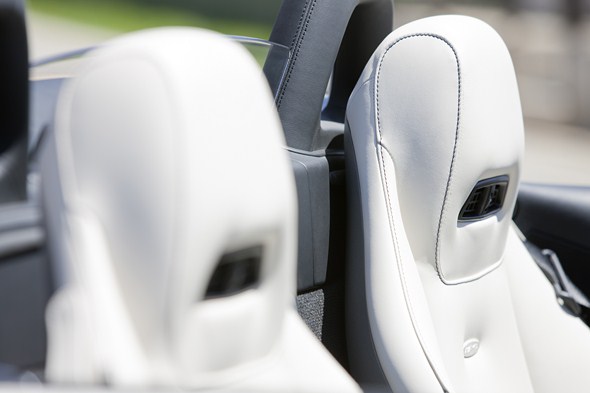
Design
Purist, athletic, exclusive and breathtaking
- Purist design for passionate sportiness
- Striking front end with features from the 300 SL Roadster
- Powerful, muscular side aspect
- Interior inspired by aircraft engineering
Perfect proportions and purist lines for an exciting presence: the design of
the SLS AMG Roadster stirs the emotions. Whether with the soft top open
or closed, the Roadster exudes passionate sportiness and sheer exclusivity.
The new super-sports car reinterprets the breathtaking lines of the iconic Mercedes-Benz 300 SL Roadster from the 1950s, and continues the legend
of exciting sports cars bearing the Mercedes star.
Memories of the legendary Mercedes-Benz 300 SL are also rekindled by the hallmark wide radiator grille with the large Mercedes star and the wing-shaped cross-fin. The three-dimensional, sculptured front-end with its low-set, arrow-shaped front apron set well into the sides lends the SLS its powerful stance on the road. Six large cooling air intakes and the vertically arranged headlamps set well to the outside with their alluring inner ambience provide a dominant aura, and are also stylistically reminiscent of the 300 SL Roadster. The central bi-xenon low-beam headlamp with its metallic wing section is framed by two LED indicator strips at the top and by the LED daytime running lamps at the bottom.
Sheer dynamism is not only suggested by the almost two-metre long bonnet, the low greenhouse set well to the rear and the short rear end with the extending rear aerofoil, but also by the long wheelbase, wide track and large wheels. The short overhangs characterise the athletic proportions as strongly as the overall engineering concept for this super-sports car, with its low-mounted front-mid engine and dual clutch transmission in a transaxle configuration.
Design influences from aircraft construction
Allusions to aircraft construction come courtesy of the prominent Mercedes star, whose tubular section is reminiscent of the air intake on a jet engine when viewed from the side, as well as the long bonnet: as the eye is drawn forward, so the observer becomes more aware of the curved bonnet contour. The design of the four fins with their Silver Shadow finish adorning the two
air outlet grilles on the end of the bonnet creates the same visual impression. These aircraft-style lines also visually accelerate the air that flows past –
and make the SLS AMG appear extremely dynamic even while stationary.
The fins on the bonnet are also to be found on the vehicle flanks, and here too the afficionado will rediscover a typical design feature of the 300 SL Roadster. The “6.3” lettering integrated between the fins is a clear reference to the large, naturally aspirated V8 engine. A stylish character line emerges from the side air outlet, combining visual appeal with power in combination with the dramatic effect of the flank surface. Extraordinarily appealing and unmistakable, the only 1261-millimetre high passenger compartment with its high beltlines, flat side windows and steep windscreen is in the nature of an observation post. When closed, the low fabric soft top accentuates the purist overall impression and embodies classic roadster design. When opened, the soft top is deposited behind the seats in a Z-configuration to preserve the harmonious lines. The three soft top colours of black, red and beige are available to suit the choice of nine exterior and six interior colours.
Side view dominated by muscle and shoulder
Viewing the SLS from the side, the eye is drawn to the prominent vehicle shoulder, which stretches from the front to the rear like a taut muscle. Dynamism is also enhanced by exterior mirrors mounted on the beltline. Distinctive 19-inch (front) and 20-inch (rear) light-alloy wheels fill the flared wheel arches, which stand out prominently from the flank. Three different wheel variants all provide a good view of the large, high-performance composite brakes. Seen from above, a prominent, uninterrupted line runs from the muscle to the rear. This styling feature is also picked up on the bonnet, where the eye follows a distinctive contour. On the right, a sporty filler cap
of solid metal provides another visual highlight.
Rear view that emphasises width
Dynamism and power are also suggested by the rear view of the SLS AMG Roadster. The gently sloping boot lid creates an impression of width, as do the pronounced shoulder, the closed soft top with its wide glass rear window and the flat rear light clusters. Featuring LED technology and two slim chrome inserts, the horizontally divided light clusters provide interesting perspectives. Wing-shaped LED lighting elements make for a distinctive and striking night design. Unlike in the SLS AMG Coupé, the third brake light is integrated into the boot lid.
Similarly inspired by motor racing are the black diffuser insert, the low, centrally located Formula 1-style LED foglight/reversing light and the two chromed tailpipes of the sports exhaust system. The strikingly tapered rear apron provides an unimpeded view of the wide rear wheels, lending the SLS
its self-assured stance on the road. The spoiler integrated in the boot lid is automatically deployed from a speed of 120 km/h to ensure optimum stability at high speeds. As the aerials for radio, navigation and telephone reception are invisibly integrated into the boot lid, they do not disrupt the car’s silhouette.
Interior reminiscent of an aircraft cockpit and motor racing functionality
Authentic materials and outstanding precision with respect to material quality and standard of finish: the interior of the SLS AMG Roadster already thrills at first sight. As in the gullwing model, the Roadster cockpit creates associations with an aircraft cockpit. The characteristic styling feature is the dashboard, whose powerful and dramatic wing shape makes for an impression of width. Strikingly integrated into the dashboard are the galvanised air vents with their adjustable, cruciform nozzles and Silver Shadow finish – their shape reminiscent of a jet’s engines. The instrument cluster with its LED upshift indicator and two white backlit dial instruments adds another decidedly sporty touch with its metallic Silver Shadow finish. The silver dials have red-lit needles and a 360‑km/h scale. As a central feature of the cockpit, the COMAND APS multimedia system is integrated between the two centre air vents.
The elongated centre console in matt metal similarly picks up on the design theme of an aircraft cockpit. It is home to the AMG DRIVE UNIT, which is inclined towards the SLS driver and allows him to choose his personal vehicle setup. The E-SELECT shift lever, whose styling recalls the thrust control of a jet, controls the AMG SPEEDSHIFT DCT 7-speed sports transmission. The solid metal selector lever is lined with high-grade leather bearing an embossed AMG emblem. The attractively integrated control unit for the electric soft top is located in the rear section of the centre console.
Numerous controls are precision-made from solid metal, with a high-sheen Silver Shadow surface. On request the centre console and other interior features such as the door sill panels, interior door trim and seat backrest trim are available in carbon-fibre. Alternatively AMG trim in high-gloss black is available for the centre console.
Authentic cockpit atmosphere in the interior
The concave shape of the interior door panels and the high beltline make for an authentic cockpit atmosphere. Together with the wide centre tunnel extending well to the rear, they reinforce the impression of safety and security. Topstitching and contrasting seams, as well as fine designo leather on the sports seats, create a luxurious impression and accentuate the hand-finished look. All surfaces such as the interior door panels and armrests are softly padded for a very pleasant feel.
Dynamic steering wheel design and six different leather colours
An authentic racing car touch is provided by the AMG Performance steering wheel with a diameter of 365 millimetres. The rim has a flattened lower section and an oval cross-section, plus perforated leather in the ergonomically formed grip area, for outstanding vehicle control. The shift paddles and lower insert are of metal. The unmistakable attention to detail for which Mercedes designers are known is very evident in the tasteful colour combinations in the interior. Six different single-tone designo leather colours are available to meet individual preferences: black, espresso brown, sand, classic red, light brown and porcelain. The sports seats with integrated head restraints and sporty transverse fluting are upholstered in designo leather, with a metal AMG badge in the backrests. Two-tone designo Exclusive leather seats are also available in espresso brown/black, classic red/black, sand/black and porcelain/black. If light brown is chosen as an interior colour, the sports seats are upholstered in natural leather with particularly high-quality woven leather on the centre seat panels.
The A-pillars are lined in anthracite Alcantara, heightening the functional, purist motor sports atmosphere. These surfaces are complemented with the sporty carpeting and floor mats bearing the AMG logo.
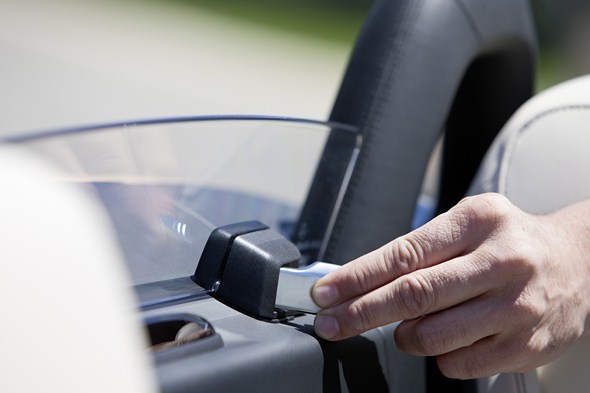
Bodyshell and safety
Lightweight construction and stability for outstanding driving dynamics and best-possible safety
- Aluminium spaceframe weighing only 241 kilograms
- Weight-optimised fabric soft top with magnesium components
- Opening and closing in eleven seconds, even at speeds up to 50 km/h
- High standard of safety and the quality typical of a Mercedes
- Final assembly at the Mercedes-Benz plant in Sindelfingen
Driving dynamics that are the hallmark of the brand, uncompromising lightweight construction, maximum stability and typical Mercedes safety –
all these apply to the SLS AMG Roadster. These four factors take their origin from the aluminium spaceframe, which at 243 kilograms is just two kilograms heavier than that of the gullwing variant. As the Roadster variant was already taken into account during the conceptual phase for the SLS AMG, the lightweight yet extremely rigid aluminium spaceframe was defined correspondingly early. Dispensing with the fixed roof and gullwing doors meant that the side skirts needed to be of more robust construction. Research and driving trials showed that the driving dynamics can be improved even further by this means, therefore side skirts with larger wall thicknesses and more chambers were developed for the open-top SLS AMG.
A few specific modifications to the aluminium spaceframe
In order to achieve handling dynamics identical to those of the Coupé, despite the lack of a fixed roof, the Roadster has two features designed to increase
the rigidity of the bodyshell: the cross-member carrying the dashboard has additional supporting struts at the windscreen frame and at the centre tunnel, and a strut mounting stay between the soft top and the tank rigidifies the rear axle. These features prevent unwanted vibrations from the start, and make the use of additional, weight-increasing vibration dampers such as those often employed by competitors unnecessary. As another important aspect, it is only
if the bodyshell has the requisite rigidity that the soft top can be safely and reliably opened and closed electrohydraulically while on the move at up to
50 km/h.
Owing to the omission of the coupé roof and gull-wing doors, the open-top
SLS AMG has a reinforcing cross-member behind the seats which supports the fixed rollover protection system. Not forgetting the 250-watt subwoofer of the Bang & Olufsen BeoSound AMG high-end sound system: this is accommodated
in the cross-member, as the Coupé-specific location on the parcel shelf is not available owing to the Roadster’s soft top. One particular challenge was acoustic insulation of the cross-member, which acts as a subwoofer housing for the two 165-millimetre speakers connected in series. Numerous improvements became necessary before the required listening pleasure was achieved. It was only with the help of a special bulkhead within the aluminium cross-member that all audiophile standards could be satisfied.
Lightweight yet rigid aluminium spaceframe
The aluminium spaceframe provides the ideal conditions for a very lightweight but extremely rigid structure. It is not only high static and dynamic flexural and torsional rigidity that plays an important part, but also the absorption
and transfer of extreme linear and transverse forces from the powertrain and suspension. The aluminium spaceframe of the SLS AMG Roadster consists of cast aluminium components and aluminium sections. Cast components are used at the nodal points where forces come together or where functions are highly integrated, i.e. where large forces must be transferred or where large components such as the doors or dashboard are attached. Cast components have the advantage of specific redirection of forces, and make it possible to vary wall thicknesses locally according to the loads encountered. Areas of greater rigidity can therefore be incorporated where required, for example
at the chassis connections. Moreover, only the necessary wall thickness is provided at any point of the structure, which saves weight in the areas subject to lower forces.
With the help of so-called topology optimisation the cast components of the aluminium spaceframe are specifically weight-optimised: ribbed structures precisely follow the force paths, while wall thicknesses are reduced to a minimum in less highly stressed areas. Topology optimisation also helps
to lower the vehicle’s centre of gravity.
Torsionally rigid structure with an intelligent material mix
Lightweight aluminium sections connect the nodal points to a sturdy structure. The large, low-set cross-sections of these aluminium sections ensure high resistance torque, thus providing the required direct transfer of drive, braking and suspension forces. The structure prevents unwanted flexibility, which means that the vehicle responds rigidly, directly and almost without torsion.
50 percent of the intelligently designed, weight-optimised aluminium spaceframe is of aluminium sections, 26 percent of sheet aluminium, 18 percent of cast aluminium and 6 percent of steel. Maximum occupant safety is ensured by the use of ultra-high-strength, heat-formed steel in the A-pillars. The bodyshell weighs a mere 241 kilograms – an absolute benchmark in the super sports car segment in relation to the peak output of 420 kW (571 hp).
Low centre of gravity and transverse reinforcing struts for superb dynamism
The entire vehicle concept has been designed to achieve the lowest possible centre of gravity. This applies both to the low connection of the powertrain
and axles, as well as to the arrangement of the rigidity-conducive bodyshell structure, which has been kept as low as possible. Examples include the rigid flexural and torsional connections between the front and rear section and the safety passenger cell, which have been realised consistently using force paths that are as low as possible. This results not only in a low centre of gravity, but also in a harmonious and therefore efficient force path in the vehicle structure.
Another prominent feature of the lightweight construction are the transverse reinforcing struts at the front and rear axles, which are integrated into the bodyshell structure. The sections connect the side members precisely where the highest forces act upon the bodyshell under dynamic cornering. The advantages of this sophisticated solution include unrivalled transverse rigidity and the avoidance of heavy secondary reinforcements or supports.
Body of aluminium and plastics
The aluminium spaceframe carries an equally lightweight outer skin: the bonnet, wings, doors and side walls are of aluminium, while the front and
rear aprons, side sill panels and boot lid are of plastic. The boot lid not only accommodates the automatically extending aerofoil, but also the third brake light and — invisible from the outside — also the aerial systems for the radio, telephone and navigation.
Lightweight soft top opens and closes in just eleven seconds
The three-layered fabric soft top of the SLS AMG Roadster, which is deposited behind the seats in a Z-formation to save space, is also an aspect highly relevant to handling dynamics. This weight-optimised, combined magnesium / steel / aluminium construction ensures a low centre of gravity and is designed for speeds up to the maximum of 317 km/h (electronically limited). Whether open
or closed, even at top speed, the occupants hear no intrusive flapping, booming, hissing, clattering, whistling or howling. Likewise the push-on draught-stop
and the panelling in the interior, on the soft top and along the beltline must be vibration-free. In short, nothing must be allowed to compromise the open-air enjoyment. The basis for verified, customer-compatible results in extreme conditions is provided by precisely defined test drives on the high-speed tracks in Papenburg, Nardo (Italy) and Idiada (Spain).
The excellent acoustics – which AMG engineers have naturally also verified with sophisticated measuring technology – also benefit from another special feature, namely the seamless, bonded-in rear window of single-layer safety glass. A special production process not only ensures a smooth transition between the outer skin of the soft top and the glass, as the sum of these design measures
also leads to low wind noise when the roof is closed – at any speed.
125 years of experience with innovations in open-top vehicles
Ensuring that the soft top is wind and water-proof is a complex undertaking, and AMG and Mercedes-Benz have used the enormous experience gained during 125 years of innovation. There have always been open-top vehicles in the history of Mercedes-Benz – and unlike in the case of many competitors,
in an uninterrupted sequence.
Every soft top is different, however, and even objectives already defined become more ambitious over time. The five challenges to which the AMG developers of the SLS AMG Roadster gave great attention and commitment were water, sand, dust, heat and cold. One special feature of the compact soft top is the continuous water pocket: this is attached below the soft top to catch rainwater and direct it down to the underbody via two apertures on each side.
Endurance test with 16 criteria: the “Sindelfingen rain test”
The rain test at the Mercedes Technology Center (MTC) in Sindelfingen is particularly demanding, and every new vehicle bearing the Mercedes star is required to pass it – whether it has a fixed roof, a soft top or a vario-roof. Extreme quantities of water are used to ensure that the result of the development work is 100% watertight – which is a particular challenge in the case of roadsters or cabriolets. 16 tests must be successfully absolved before approval is granted.
Whether during the hose test, when all soft top, door and flap seals are sprayed with a water-hose, the continuous, overnight rain test, the fording test, the icing, swirl and high-pressure tests, or the final session in an automatic car wash – the rain test simulates every conceivable situation that can occur on any continent.
Bench testing and practical trials in all climatic zones
In addition to various test facilities such as the water chamber and the climate/ wind tunnel, the AMG specialists have recourse to test drives in all climatic regions of the world, where problems can be identified and solutions sought.
In Laredo, Texas, for example, there is a particularly fine dust which finds its way into practically any gap – and tests the seals to the absolute utmost.
The compact fabric soft top must also submit itself to various tortures. One of these is the standardised soft top endurance test used for all new Mercedes roadsters or Mercedes cabriolets: 20,000 closing cycles on a stationary test rig must present no problem for the hydraulic cylinders, electric motors and joints. There are also 2500 closing cycles while on the move, whether in great heat, icy cold, high humidity or dry desert winds. In this area too, nothing is left to chance – and for excellent reasons: the aim of this enormous effort is to give the customer limitless driving pleasure in their SLS AMG Roadster.
Final quality check on the complete vehicle
All the optimisation stages have been absolved, and the production tests at the Mercedes-Benz plant in Sindelfingen have been successful, but the developers have still not reached their goal. The quality of the overall vehicle is now the focus of the accompanying endurance trials. These simulate an entire vehicle life under the toughest conditions in accelerated test cycles. The aim is to verify the level of maturity before production of customer vehicles commences.
The endurance testing at a glance:
Long-term testing on a variety of different roads:
- all the components and systems are tested together in everyday operation. Loaded up to their permitted gross vehicle weight, the test cars are put through a precisely defined test programme on country roads, on motorways and in city traffic.
Endurance testing on heathland:
- in this case, the developers focus on the durability of the chassis and suspension components, the entire bodyshell and the integral subframe
on which the front axle, steering and engine are mounted. The test cars
are loaded up to their permitted gross vehicle weight.
“Accelerated” endurance testing:
- testing of the entire vehicle, focussing on the powertrain, chassis
and suspension. Special features of the AMG programme include 10,000 kilometres on the Nürburgring’s North Loop and
10,000 kilometres in city traffic.
Full-load endurance testing:
- extreme acceleration and braking manoeuvres with a high proportion of full-load operation, making extreme demands on the cooling, fuel-delivery and braking systems.
Long-term corrosion testing:
- corrosion testing of the entire vehicle simulates the toughest dynamic
and climatic environmental influences.
Final board approval:
- all-inclusive verification of the degree of development and production maturity.
Exemplary aerodynamics for optimum handling stability
The best possible handling stability, low drag and low wind noise – the aerodynamic requirements for the SLS AMG Roadster were extremely demanding during its design and development. The specialists at Mercedes-Benz and AMG invested a great deal of time to achieve the best possible aerodynamic balance – with the help of computer simulations, tests in the wind tunnel and test drives on various high-speed tracks. The result is a combination of slight lift at the front axle and downforce at the rear axle. This is a desirable combination for a super-sports car with a front-mid-engine, as it ensures dampened responses to steering impulses at high speeds. Thanks to this aerodynamic configuration, critical driving situations can be prevented at source – for example during a sudden avoiding manoeuvre at high speed. The driver benefits from a constant feeling of safety and stability. All in all, the aerodynamic balance of the SLS AMG places it in the top echelon of the super-sports car segment.
The downforce at the rear axle is determined by the automatically extending aerofoil. This feature attractively integrated into the boot lid extends at
120 km/h, and ensures the right aerodynamic balance in all speed ranges. The aerofoil retracts again when the speed falls below 80 km/h. If required by the driver, the rear aerofoil can also be manually extended by pressing the relevant button in the AMG DRIVE UNIT. The aerodynamically efficient shape of the
A-pillars, which have no drainage channels, and the exterior mirrors fitted to the beltlines ensure that the airflow strikes the aerofoil at favourable angles in all speed ranges. The rigidity of the rear aerofoil is so designed that its angle of pitch is specifically modified by the air pressure at high speeds, which leads to improved air resistance with only a slight change to the rear axle downforce.
Good Cd value of 0.36
With a Cd value of 0.36 and a cross-sectional area (A) of 2.11 sq. m., the
air resistance (Cd x A) amounts to 0.76 sq. m. (Coupé in comparison:
Cd x A = 0.77 sq. m.). These figures are achieved by a favourable airflow into the front-end cooler modules and a precisely calculated airflow through the engine compartment. Spoilers in front of the front wheels improve the airflow around the tyres and reduce lift. The front wheel arch linings feature vertically installed louvres which conduct the airflow away from the radiator area with no effect on lift.
The engine compartment cladding, the almost completely smooth underbody and the rear diffuser also play an important part in the aerodynamics of the SLS AMG. The favourable design of the front apron with a centrally integrated spoiler lip, plus the diffusors fitted at the sides of the engine compartment cladding, enable front axle lift to be effectively reduced. The rear diffuser is clearly visible between the exhaust tailpipes: this directs the airflow upwards, acting together with the aerofoil to prevent lift at the rear axle.
Painstaking attention to detail has also paid off where the boot lid is concerned: this is where air turbulences are normally created which can brake the airflow and unnecessarily increase fuel consumption. This is prevented by a discreet spoiler lip in the centre area of the boot lid edge, which effectively cuts off the airflow.
Low wind noise thanks to sophisticated aero-acoustics
The low wind noise of the SLS AMG is likewise a result of these extensive
tests; this also contributes greatly to the long-distance comfort typical of any Mercedes. Not only the small, rounded surfaces of the doors and the flush side windows, but also the design of the A-pillars, door handles and exterior mirrors have a positive effect on this aspect. Effective sealing systems and the deliberate absence of drainage channels in the A-pillars further illustrate
the sophisticated aero-acoustics of the SLS AMG Roadster.
Minimisation of soiling to the exterior mirrors, side windows and rear window makes a major contribution to active safety. The special shape of the exterior mirror housings redirects dripping rainwater to almost entirely prevent soiling of the mirror lenses and side windows. The side windows also have a water-repellent coating to optimise all-round visibility in poor weather conditions.
High standard of safety and the quality typical of a Mercedes
The new SLS AMG Roadster also meets the high passive safety standards that
are traditional at Mercedes-Benz. Right from the outset, the specified lightweight construction and outstanding crash characteristics were designed to be in line with the car’s low centre of gravity and the best possible distribution of load paths. The latter are specifically conducted around the occupants – this applies to front, rear-end and lateral collisions, as well as to roof impacts.
The entire bodyshell design is based on what actually happens in accidents. During a frontal collision, for example, the continuous side member extends from the front cross-member to the side skirt, and directs the impact energy into the extremely rigid structure of the door sill. As a result the passenger compartment remains undistorted during the usual frontal impact tests. One typical characteristic of the SLS is the front-mid-engine layout of the drive unit. This positioning behind the front axle provides a large deformation zone in front of the engine. This in turn allows a firewall of reduced weight, as it is required to absorb far less energy during a frontal crash than in a vehicle
with a conventionally positioned engine.
The torque tube connecting the engine to the dual clutch transmission located at the rear axle also helps during a crash: in the event of either a frontal or rear-end collision, the torque tube lowers the stresses on the bodyshell by specifically transferring and dissipating the impact forces. During a lateral impact, protection is provided by a side impact reinforcement of cold-formed, ultra-high-strength steel which is integrated into the doors. This is supported by the relevant A and B-pillars, and transfers the impact forces to the body structure via special elements. The load paths in the areas of the door beltlines are optimised by multi-layered reinforcing sections.
Computer simulation of crashes with the complete vehicle
Sophisticated computer simulations helped to optimise all the structural components. To verify the results, numerous crashes with the complete vehicle were simulated by computer. The aim was to achieve an outstanding crash performance combined with low weight. The relevant structural cross-sections were dimensioned according to the expected loads and load paths. The salient factors were the geometrical layout of the load paths and selection of the most suitable aluminium alloys for each component with respect to energy absorption, rigidity and strength. Choosing the best possible joining techniques and defining the wall thicknesses for all the components, taking into account the loads encountered during normal operation and during a crash, were also of decisive importance.
During the course of its development, the SLS AMG was subjected to numerous crash tests, plus additional component tests to verify the results. The new super sports car complies with all country-specific impact configurations necessary for an operating licence. Plus all the current ratings and consumer tests, and also the particularly demanding, in-house impact tests of which some go well beyond the legal requirements. Passing these is a precondition for the highest accolade in automobile safety: the Mercedes star.
Eight airbags as standard, Blind Spot Assist on request
The sophisticated body structure with its fixed roll-over protection system is perfectly complemented by the very latest restraint systems. Three-point seat belts with reversible belt tensioners and belt force limiters, plus eight airbags, are provided as standard passive safety features for occupants of the SLS AMG Roadster. The airbag system includes two adaptive airbags for the driver and passenger, a kneebag for each, two sidebags integrated into the sports seats and two separate windowbags deploying from the door beltlines.
The LEDs of the adaptive brake light flash 5.5 times per second during emergency braking. This significantly reduces the reaction time of traffic following behind. The new, optional Blind Spot Assist further improves active safety. This visual and acoustic warning system uses the short-range sensors of the standard PARKTRONIC system to detect vehicles in the driver’s blind spot. If the system registers another vehicle in the blind spot, the driver is warned by a red triangle appearing in the relevant exterior mirror. An acoustic warning is given in addition if he nonetheless activates the indicators.
Blind Spot Assist can warn the driver at speeds of 30 km/h or more. The monitored area extends around 3.5 metres to each side of the vehicle, and three metres behind the vehicle rear. Registered vehicles which are overtaking are indicated immediately after entering the monitored zone if the relative speed difference between the vehicles is no more than 16 km/h. Vehicles which have just been overtaken are indicated with a delay of 1.5 seconds
after entering the zone, which avoids unnecessary, distracting warnings.
Exclusive hand-production in three locations
The aluminium spaceframe and body are exclusively hand-built with strict adherence to stringent quality standards by Magna Steyr Fahrzeugtechnik GmbH in Graz/Austria. Highly qualified specialists join the aluminium components together using the very latest processes. The most suitable joining technique is used for the relevant requirement – riveting, bonding, welding and bolting.
Hand-assembly is also very much the order of the day at the AMG engine
shop in Affalterbach, where the 420 kW (571 hp) AMG 6.3-litre V8 engine is produced according to the “One man, one engine” philosophy. This is visually confirmed by the AMG engine plate, which bears the signature of the technician responsible for its assembly. Final assembly of the SLS AMG Roadster is carried out by chosen personnel at the Mercedes-Benz plant in Sindelfingen. In summer 2008 the Sindelfingen plant was presented with the J.D. Power Award by the prestigious US market research institute J.D. Power and Associates. This award is given for the automotive production facility with the best delivered quality worldwide.
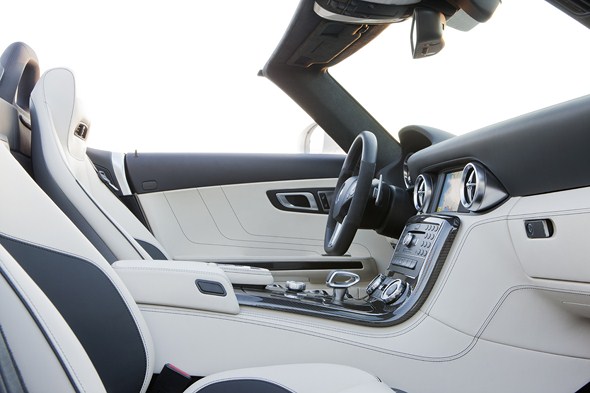
Engine and power transmission
Naturally aspirated eight-cylinder engiine with transaxle dual clutch transmission
- Output of 420 kW (571 hp) and 650 newton metres of torque
- Exhilarating responsiveness and emotional engine sound
- Dry sump lubrication to keep the centre of gravity low
- Seven-speed dual clutch transmission at the rear axle
- A torque tube connects the AMG V8 engine to the transmission
Eight cylinders and a displacement of 6.3 litres in a front-mid-engine arrangement, a high-revving concept, dry sump lubrication and a performance-oriented intake and exhaust system: opening the almost two-metre long bonnet of the SLS AMG affords a view of an outstanding high-performance engine. With a peak output of 420 kW (571 hp) at 6800 rpm and 650 newton metres of torque at 4750 rpm, the AMG 6.3-litre V8 unit delivers first-class performance figures. The Roadster accelerates from zero to 100 km/h in 3.8 seconds, reaches 200 km/h in 11.3 seconds and has a top speed of 317 km/h (electronically limited). The DIN kerb weight of 1660 kilograms produces
an extremely favourable power-to-weight ratio of only 3.95 kilograms per kilowatt or 2.9 kilograms per hp.
The use of specific fuel economy measures has enabled a fuel consumption of 13.2 litres per 100 kilometres (NEDC combined) to be achieved. Power transfer in the SLS AMG is by a new, seven-speed AMG dual clutch transmission located at the rear axle in a transaxle arrangement. It is rigidly connected to the engine by a torque tube.
The combination of a high-revving concept and a large displacement achieves the best of both worlds: exhilarating flexibility accompanied by high torque at low engine speeds. The new AMG V8 already delivers 545 newton metres to the crankshaft at 2500 rpm, with the maximum torque of 650 newton metres on tap from 4750 rpm – more than any other naturally aspirated engine in
this output and displacement class. In short, the new AMG eight-cylinder guarantees dynamic acceleration, rapid intermediate sprints and sheer driving pleasure at the highest level, or relaxed, day-to-day cruising when preferred.
Key data at a glance:
| Mercedes-Benz SLS AMG Roadster | |
| Cylinder arrangement | V8 |
| Cylinder angle | 90° |
| Valves per cylinder | 4 |
| Displacement | 6208 cc |
| Bore x stroke | 102.2 x 94.6 mm |
| Cylinder spacing | 109 mm |
| Compression ratio | 11.3 : 1 |
| Output | 420 kW (571 hp) at 6800 rpm |
| Output per litre | 67.6 kW (92.0 hp) |
| Max. torque | 650 Nm at 4750 rpm |
| Torque per litre | 104.7 Nm |
| Maximum engine speed | 7200 rpm |
| Mean pressure | 13.16 bar |
| Engine weight (dry) | 205 kg |
| Power/weight ratio | 0.36 kg/hp |
| Fuel consumption NEDC combined | 13.2 l/100 km |
| CO2 emissions | 308 g/km |
| Acceleration 0 – 100 km/h | 3.8 s |
| Acceleration 0-200 km/h | 11.3 s |
| Top speed | 317 km/h* |
* electronically limited
Optimum cylinder charging thanks to newly designed intake air ducting
The newly calculated, more flow-efficient design of the intake air ducting leads to a reduction in pressure losses, and the magnesium intake manifold has precisely configured resonance tube lengths. Eight velocity stacks with a length of 290 millimetres and a diameter of 51.5 millimetres supply the combustion chambers with fresh air. Behind the air filters with a volume of just under 9500 cubic centimetres there are two throttle flaps with a diameter of 74 millimetres. Their electronic adjustment is practically instantaneous: it takes only 150 milliseconds to open the two throttle flaps to their maximum. The result is exhilarating responsiveness. Two hot-film air mass sensors located behind the air filters supply the engine electronics with the necessary temperature and density data for the intake air.
One special characteristic of the V8 engine is its sophisticated valve drive, which borrows features from the powerful AMG racing engines. The 32 valves in the cylinder heads are operated by bucket tappets. Their space-saving design allows a stiff valve train and therefore high engine speeds with large valve opening cross-sections, which in turn benefits output and torque. The large intake valves have a diameter of 40 millimetres, while their opposite numbers on the exhaust side measure 34 millimetres. In contrast to a racing engine, the valve drive is maintenance-free with hydraulic valve clearance compensation.
Four continuously variable overhead camshafts
All four overhead camshafts are continuously variable over a range of
42 degrees. Both the intake and exhaust camshafts are adjusted as a function of engine load and engine speed, ensuring extremely high output and torque values as well as smooth idling and especially low exhaust emissions. Depending on the engine speed, the valve overlap can be varied to ensure an optimal supply of fuel/air mixture to the combustion chambers and efficient venting of the exhaust gases. The variable camshaft adjustment is controlled electrohydraulically, and monitored by the engine control unit.
Distinctive exhaust note with two exhaust headers
Optimised performance and an emotional sound signature: these were the requirements when developing the sports exhaust system. Exhaust headers with precisely coordinated tube lengths – a further technology transfer from motor racing – ensure a significant increase in output and torque by improving the gas cycle. The large pipe cross-sections of the newly developed twin exhaust system effectively reduce the exhaust counterpressure. Two relatively small pre-silencers on the underbody and a large, transversely installed main silencer at the rear help to ensure optimum weight distribution.
The AMG specialists attached particular importance to the sound signature of the eight-cylinder power unit, and exhaustive tests were carried out to achieve a synthesis of immediately perceptible dynamism and the long-distance qualities typical of a Mercedes. Great attention was also paid to the elimination of irritating noises, while accentuating the frequencies perceived as pleasant and typical of a sports car. Especially when the soft top is down, the engine note accentuates the emotionally appealing character of the SLS AMG Roadster. At the same time it was of course necessary to comply with
the legal requirements – for example when measuring passing noise.
The two exhaust tailpipes integrated into the rear apron emit a characteristic eight-cylinder sound which tells every car-lover: here comes a genuine AMG. Two ceramic catalytic converters optimised for counterpressure and located at the firewall directly by the exhaust header, plus two metal catalytic converters on the underbody, provide effective exhaust gas aftertreatment and ensure compliance with all current and future limits such as EU 5, LEV 2 and U‑LEV. The new AMG engine also easily meets specific requirements for the US market, such as Onboard Diagnosis II and lambda sensor diagnosis.
Dry sump lubrication to keep the centre of gravity low
One major criterion when formulating the technical concept for the SLS AMG Roadster was the installed position of the engine. The requirement was for the engine to be positioned low down and well to the rear, so as to lower the car’s centre of gravity significantly and achieve a balanced weight distribution between the front and rear axles. The solution found, namely to install the eight-cylinder power unit as a front-mid engine behind the front axle, combining it with a transmission in a transaxle layout, led to an optimum weight distribution of 47 percent at the front and 53 percent at the rear.
The much lower installed position of the V8 engine is the result of a changeover to dry sump lubrication – which eliminates the usual oil sump.
The dry sump lubrication system of the M159 consists of a suction pump, a pressure pump and an external 5-litre oil tank located in front of the engine. All in all, 13.5 litres of engine oil circulate around the complete system. The oil scavenging pump sucks the oil directly from the crankcase and cylinder heads, delivering it to the external oil tank at a maximum rate of 700 litres per minute. This efficient oil scavenging further improves the efficiency of the engine.
The reciprocating pressure pump conveys the oil from the external oil tank back to the engine, ensuring effective lubrication even under the high lateral acceleration forces that usually occur on racetracks. The demand-related control of the oil pressure pump is based on the engine speeds programmed into the control unit, as well as the characteristic maps for temperature and engine load. This leads to a reduction in the engine’s power dissipation, and a considerable reduction in fuel consumption. Two large coolers in the front wheel arches, each with a blower fan integrated on one side, ensure that the engine oil is efficiently cooled.
Another innovation used in the engine is the so-called “gas-spring principle”, where the air compressed beneath the piston as it moves down the gas-tight crank chamber is prevented from escaping. On the upstroke the rebound energy is almost completely returned to the pistons. This principle prevents flow losses. Another positive effect is the much greater rigidity of the crankcase. The gas-spring principle has enabled fuel consumption to be reduced by 1.5 percent – while increasing output by 7 kW (9.5 hp).
Outstanding strength and optimised lightweight construction also
for the engine
The eight forged pistons, which are together 0.5 kilograms lighter than cast pistons, reduce oscillating masses and improve both responsiveness and flexibility. Optimum cooling of the severely stressed piston crowns is by means of pressure-controlled oil-spray nozzles in the crankcase. As another specific weight-saving measure, there are no steel liners locating the main crankshaft bearings. The crankcase of the M159 is wholly of aluminium, and around
4 kilograms lighter than its counterpart in the M156. To reduce weight even further, aluminium bolts are mainly used in the M159. This saves another
0.6 kilograms or so compared to steel bolts. The dry weight of the V8 engine in the SLS is 205 kg, producing a first-class power-to-weight ratio of 0.36 kg/hp.
As is usual in motor sports, the crankcase is a rigid bedplate design of closed-deck construction. The engine block and cylinder heads are of cast aluminium-silicon alloys (AlSi7 and AlSi17) which represent the state of the art in terms of weight, thermal and mechanical resistance and long-term strength. As in the M156, the engine specialists at Mercedes-AMG use a particularly advanced process for the eight cylinder walls to produce a tribologically optimal surface, the so-called NANOSLIDE technology. The advantages are extremely low friction and wear accompanied by outstanding long-term durability. A considerably harder surface is achieved compared to conventionally coated cylinder walls.
Cooling module of weight-optimised design
The coolant is cooled by a large cooler module located behind the radiator grille. The condenser for the air conditioning and the cooler for the steering servo fluid are also integrated into this module. As a particular bonus, this weighs around 4 kilograms less than conventional components – while improving efficiency at the same time. A large suction fan located directly behind the radiator conducts the hot air away as required.
Efficient control unit for generator management
The Bosch ME 9.7 AMG control unit also has a generator management function as a further system that helps to save fuel. Sensors monitor the charge status
of the vehicle battery, and reduce the output of the generator if the battery
has sufficient charge. The system uses the overrun phases of the engine to recharge the battery, braking energy being converted into electrical energy
by recuperation.
Careful combination of efficiency-enhancing measures has enabled an NEDC combined fuel consumption of 13.2 litres per 100 km (premium petrol) to be achieved. This is an outstanding figure, as the new SLS AMG is after all one of the most powerful cars in the super-sports car segment.
Engine production at the Affalterbach plant
The new V8 powerpack for the SLS is produced in the ultra-modern AMG engine shop, on the “One man, one engine” principle. This means that a single technician assembles the engine by hand from start to finish – as witness the high-quality AMG engine plate bearing the signature of the technician responsible. The design of the AMG eight-cylinder is also a feast for the eyes, starting with the new, titanium grey cover of the magnesium intake manifold with its two prominent AMG logos, and the optional carbon-fibre engine compartment cover that frames the high-performance power unit so attractively.
AMG seven-speed dual clutch transmission with RACE START
The ideal partner for the powerful, naturally aspirated eight-cylinder engine
is the AMG SPEEDSHIFT DCT 7-speed sports transmission – a dual clutch transmission with seven gears, four driving modes and a RACE START function. The advantages of this technology, which is once again derived from motor racing, include highly responsive gearchanges without any interruption in tractive power, a tailor-made control strategy and improved gearshifting comfort. Specifically configured for the high-revving nature of the AMG
6.3-litre V8 engine, the AMG SPEEDSHIFT DCT 7-speed sports transmission provides optimum ratios with only small rpm changes. In short, the new transmission gives the driver even more dynamic acceleration for maximum driving pleasure.
AMG DRIVE UNIT with four driving modes for maximum pleasure
The central control point for the AMG SPEEDSHIFT DCT 7-speed sports transmission and all dynamic control functions is the AMG DRIVE UNIT. The rotary electronic control for selection of the four driving modes and activation of the RACE START function is located to the left of the E-SELECT shift lever.
The dual clutch transmission allows upshifts under full load both in automated and manual mode, where the gears can be shifted using the AMG shift paddles on the steering wheel. There is a choice of four driving modes for maximum driving pleasure and comfort: “C” (Controlled Efficiency), “S” (Sport), “S+” (Sport plus) and “M” (Manual). In Controlled Efficiency mode the high
torque already available at low engine speeds is used to shift up to the highest viable gear. The resulting dethrottling effect on the intake side lowers fuel consumption, with accompanying benefits in terms of engine noise. Controlled Efficiency also means comfortable gearchanges and “soft” accelerator characteristics for relaxed cruising.
In “S” mode the transmission remains in each gear to a higher speed, downshifts are faster and gearshifts are performed around 20 percent more rapidly than in “C” mode. Switching to “S+” mode shortens gearshift times by a further 20 percent, while “M” is the most sporty mode of all: the AMG 6.3-litre V8 engine now responds with even more “bite”, and the AMG dual clutch transmission changes the gears another 10 percent faster – a total reduction of 50 percent compared to “C” mode. In “M” mode the transmission performs gearchanges in less than 100 milliseconds. The upshift indicator integrated into the AMG instrument cluster informs the driver when a manual gearchange is advisable: seven LEDs coloured white, yellow and red indicate the necessary action. The faster the engine speed approaches the maximum of 7200 rpm, the more LEDs light up.
Best possible traction thanks to the RACE START function
The RACE START function delivers maximum dynamism: in order to use it,
the driver has to activate the ESP® Sport function while the vehicle is at a standstill, and press the brake pedal with his left foot. Having preselected the RACE START program using the rotary switch, the driver is presented with a confirmation message in the AMG central display. After confirming the RACE START function by pulling the “Up” shift paddle once, all he has to do is depress the accelerator fully and take his foot off the brake. The optimum start-up engine speed is set fully automatically, and the SLS AMG accelerates away with flawless traction – all the way up to top speed if required. The driver does not need to shift the gears manually, as the DCT transmission performs lightning-fast gearchanges.
Automatic double-declutching function for even more emotional appeal
In the “S” (Sport), “S+” (Sport plus) and “M” (Manual) modes, the automatic double-declutching function is active. Every manual or automatic downshift is accompanied by precisely metered double-declutching – incrementally from “S” through “S+” to “M”. This not only adds to the driver’s emotional experience: the load-free downshift minimises load-change reactions, which pays dividends – particularly when braking into a bend on the racetrack –
and also enhances safety in the wet or on ice.
The AMG dual clutch transmission excels with compact dimensions and a low weight of only 136 kilograms, including the differential – thanks to aluminium construction. The absence of a conventional torque converter improves efficiency and makes a significant reduction in fuel consumption possible.
A mechanical, multi-plate differential lock configured for sporty performance
at the physical limits is also integrated into the transmission housing.
Torque tube with carbon-fibre drive shaft
The torque tube turns the AMG SPEEDSHIFT DCT 7-speed sports transmission and the V8 engine into a fixed unit. The engine and the transmission installed in a transaxle arrangement at the rear axle are firmly connected with very low flexural and torsional flexibility, and support each other. This has decisive advantages in terms of handling dynamics and driving comfort, as this sophisticated solution makes it possible to eliminate much more free play from the entire powertrain. The 1.64-metre long torque tube consists of a one-piece sand-cast aluminium housing, and weighs less than 25 kilograms. A drive shaft rotates at engine speed inside the housing. As in the Mercedes-Benz C-Class DTM racing touring cars, the shaft is made from carbon-fibre. One of the key advantages of this high-tech material is that despite its high strength, the shaft tips the scales at only 4.7 kilograms. This means that the 1.71-metre long drive shaft, which is required to transfer no less than 650 newton metres of torque from the engine to the dual clutch transmission, is around 30 percent lighter than a steel version would be.
A specially developed torsional damper is also active within the torque tube. This reliably eliminates resonances and vibrations, thereby optimising ride
and noise comfort.
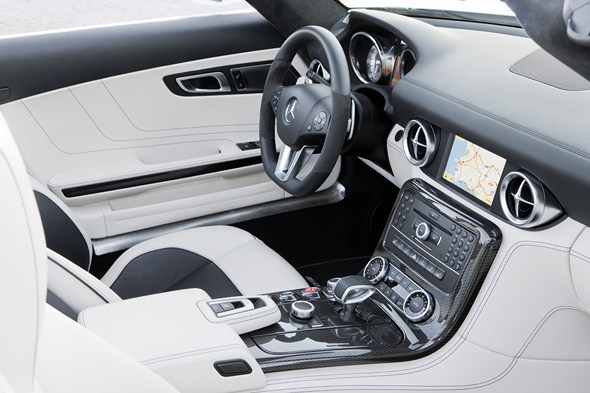
Chassis and braking system
Perfect racetrack performance and the
long-distance comfort for which a Mercedes
is known
- Aluminium suspension with double-wishbone axles
- AMG RIDE CONTROL sports suspension on request
- “Flow Forming” AMG light-alloy wheels of 19 and 20-inch size
- 3-stage ESP® and mechanical multi-plate differential lock
- High-performance ceramic composite braking system as an option
The motor sports derived technology to be found everywhere in the powertrain of the Mercedes-Benz SLS AMG Roadster is also evident in the suspension and braking system. The aluminium suspension with double-wishbone axles is designed for uncompromising lightweight construction and outstanding handling dynamics. The new AMG RIDE CONTROL sports suspension with variable, electronically controlled damping is available on request. The AMG high-performance braking system is also available in a newly developed, highly stress-resistant ceramic version, with composite brake discs all-round.
The commitment of Mercedes-Benz and AMG to building a highly desirable super sports car that combines consummate racetrack performance with hallmark Mercedes long-distance comfort has given rise to an ingenious suspension layout. All four wheels are located on double wishbones with a track rod, a technology that has proven itself in motor racing right through to Formula 1. With a double-wishbone axle, the wheel location and suspension functions remain separate; the spring/damper struts are supported on the lower wishbone. The double-wishbone concept with its high camber and track rigidity positively locates the wheel with minimal elastic movements, providing the driver with an optimum sense of road contact when driving at the limits.
The kinematics are determined by the differing lengths of the control arms and the position of the control arm anchorage points on the chassis and hub carriers. The broad base of the control arms transfers the wheel forces to the rigid steel subframe at the front axle, and into the compact and rigid, cast nodal points of the rear-end structure. The wishbones, steering knuckles and hub carriers at the front and rear are made entirely from forged aluminium – substantially reducing the unsprung masses; this configuration also notably improves the suspension response. The suspension configuration of the SLS AMG provides an optimum balance between low body roll and a taut
basic setup with a good level of comfort.
Outstandingly individual: the AMG RIDE CONTROL sports suspension
The AMG RIDE CONTROL sports suspension with variable, electronically controlled damping is available as an optional extra. Depending on the
driving situation, speed and vehicle load, this system modifies the damping characteristics almost instantly, automatically reducing the angle of body roll. For the driver this means extremely fast, imperceptible adaptation between maximum agility and optimal ride comfort – to suit the driving style and road conditions.
A small key with a major effect: pressing the shock absorber symbol also allows individual and convenient adjustment of the damping characteristics. Three stages are available: “Comfort”, “Sport” and “Sport plus”. The currently active mode is shown in the AMG main menu. “Comfort” is automatically active when the engine is started, and provides a sensitive suspension response with soft damping characteristics. “Comfort” is recommended for a comfort-oriented driving style with moderate speeds, for example in urban traffic or on motorway stretches with speed limits. But even on poor, uneven road surfaces, “Comfort” mode will be the mode of choice for many Roadster drivers owing to its rather softer damper settings.
The key in the AMG DRIVE UNIT is pressed once to activate “Sport” mode. The left control lamp in the key and the display in the AMG main menu confirm manual activation of “Sport” mode to the driver. In “Sport” the shock absorbers respond more firmly depending on the driving situation, which not leads to improved roadholding when driving in a sporty manner, but also effectively reduces body roll and pitching. In most driving situations, “Sport” mode is
the best compromise between satisfactory suspension comfort, low body movements and high agility.
“Sport plus” is activated if the driver presses the key again, and the right control lamp lights up in confirmation. In additional to higher damping forces, this mode has special control algorithms configured for a decidedly sporty driving style e.g. on uneven road surfaces – perhaps high-speed laps on a circuit. The driver is able to store his preferred setup using the AMG key in the AMG DRIVE UNIT. Sustained pressure on the AMG symbol stores the currently active suspension mode and selected transmission mode. Brief pressure will then quickly and conveniently activate the preferred combination.
Electronics monitor numerous parameters
The electronic damper control is based on acceleration sensors which register dynamic vehicle body and wheel movements, both absolutely and in relation
to each other. Other factors relevant to the driving dynamics, such as drive
and braking moments, the steering angle and lateral/linear acceleration are continuously registered and evaluated. The current vehicle speed, wheel rotation speeds and selected gear ratios are also continuously analysed. High-performance control electronics in permanent dialogue with the engine and transmission control unit ensure that the forces of the four newly developed shock absorbers are adapted practically instantly.
Depending on the selected suspension mode, different control configurations and parameter weightings are active to strike the best possible balance between comfort and dynamic performance. Electromagnetically actuated valves in the shock absorbers control the oil flow between the lower and upper chamber. In “Comfort” mode more oil flows through the valves, and less in “Sport” and “Sport plus” mode.
Long wheelbase and wide track
The long wheelbase of 2680 millimetres not only results in outstanding straight-line stability but also low wheel load shifts, significantly reducing the vehicle’s tendency to dive and squat when braking and accelerating. The broad track width – front 1682, rear 1653 millimetres – ensures lower shifts in the wheel loads from the inner to the outer wheel when cornering, enabling the tyres to retain more grip. The large caster angle of 11.6 degrees significantly increases negative wheel camber when cornering, and also improves tyre grip – this also ensures outstanding stability when braking heavily while cornering.
Weight-optimised “Flow Forming” AMG light-alloy wheels
The weight-optimised axle design is complemented with AMG light-alloy wheels produced by the new “flow forming” process. During this production process, hot forming in the area of the rim base makes for a denser material structure, thereby improving long-term durability. This also means that lower wall thicknesses can be used. The weight saving of around 1.1 kilograms per wheel compared to conventional light-alloy wheels reduces the unsprung masses, further improving the handling dynamics and suspension comfort.
The AMG light-alloy wheels in size 9.5 x 19 inches at the front and
11.0 x 20 inches at the rear are shod with 265/35 R 19 size tyres at the front and 295/30 R 20 at the rear. Four variants are available: AMG light-alloy wheels in a 7-spoke design or a 5-twin-spoke design, or alternatively two
low-weight forged wheel variants in a 10-spoke design. With an approx.
14-percent lower weight than the “Flow Forming” wheels, these reduce the unsprung masses even further. The weight saving per wheel is 1.8 kilograms. Tyres developed exclusively for the SLS AMG ensure top performance and excellent grip.
A tyre pressure control system which continuously monitors the pressure in all four tyres is standard equipment, with the data for each wheel shown in the display. During a journey, four wheel sensors on the insides of the light-alloy wheels send out continuous radio signals with information about the air pressure, tyre temperature and direction of rotation. A control unit evaluates the data and informs the driver in the event of a deviation from the nominal values. In this case the display shows the message “Check tyres!”, or in case of a sudden pressure loss “Attention. Tyre defect!”. A yellow warning lamp also lights up in the instrument cluster.
Power-assisted rack-and-pinion steering for reassuringly direct feedback
With a constant mechanical steering ratio of 13.6:1, the rack-and-pinion steering of the SLS AMG Roadster provides reassuringly direct feedback and meets the high expectations for a super-sports car. The servo assistance is speed-sensitive, improving the feedback to the driver as the speed increases – an indispensable factor when driving straight ahead at high speed. Perfect linear transfer of the steering angles is made possible by the constant velocity joint integrated into the steering system. The chosen geometry also provides plenty of scope for the performance-enhancing headers in the sports exhaust system.
Installing the steering gear on the subframe in front of the engine allows a particularly low engine position. The subframe is of high-strength steel, and is rigidly bolted to the side members. It not only optimises steering precision, but is also a key component in the front-end crash structure.
AMG high-performance braking system with composite technology
High deceleration performance, precise pedal feedback, perfect fade-resistance and superior safety reserves are the key attributes of the AMG high-performance braking system. Ventilated, grooved and perforated brake discs all-round in size 390 x 36 millimetres at the front and 360 x 26 millimetres
at the rear ensure deceleration at the highest level. Brake discs in race-tested composite technology are installed at the front axle, with the grey cast iron discs radially and axially floating, and fixed to an aluminium bowl via stainless steel connections. This sophisticated technology ensures highly efficient heat conduction, and therefore outstanding fade-resistance even with a highly dynamic style of driving.
The use of aluminium also saves weight, and in the case of the brakes this has particular advantages in terms of agility and suspension responsiveness because of the considerable reduction in unsprung masses. Six-piston fixed callipers at the front and four-piston fixed callipers at the rear allow a generous brake lining surface area of 2 x 120 sq. cm and 2 x 58 sq. cm. The optionally available, red-painted brake callipers are a new feature.
High-performance ceramic composite braking system as an option
AMG ceramic composite high-performance brakes are available as an option, and are instantly recognisable thanks to the “AMG Carbon Ceramic” logo on the brake callipers. Thanks to the special materials and production technology used to manufacture the discs from carbon-fibre-reinforced ceramic in a vacuum at 1700 degrees Celsius, the ceramic discs are much harder. This not only increases the service life many times over compared with a grey cast iron disc, but also their resistance to extreme loads and heat. The result is extremely short stopping distances, an exact pressure point and much higher fade resistance even under extreme operating conditions. The larger ceramic discs – front: 402 x 39 millimetres; rear: 360 x 32 millimetres – also feature
a composite design and are connected with a floating radial mount to an aluminium bowl.
The ceramic brake discs are 40 percent lighter in weight than the conventional, gray cast iron brake discs. The further reduction in unsprung masses not only improves handling dynamics and agility, but also ride comfort and tyre grip. The lower rotating masses at the front axle also ensure a more direct steering response – which is particularly noticeable when taking motorway bends at high speed. The ceramic discs are also corrosion-proof, and therefore unaffected by deicing salt and brine. Six-piston fixed callipers with a brake lining area of 2 x 154 sq. cm. are installed at the front, with four-piston fixed callipers and a lining area of 2 x 73 sq. cm. at the rear.
Braking system data for the Mercedes-Benz SLS AMG at a glance:
| Composite braking system | Composite ceramic braking system | |
| Front axle: | ||
| Brake disc Diameter Thickness Weight* Brake calliper Lining area | Aluminium/grey cast-iron, composite technology, ventilated, perforated, grooved390 mm36 mm 13.5 kg 6-piston aluminium fixed callipers 2 x 120 sq. cm | Aluminium/ceramic, composite technology, ventilated, perforated402 mm 39 mm 7.9 kg 6-piston aluminium fixed callipers 2 x 154 sq. cm |
| Rear axle: | ||
| Brake discDiameter Thickness Weight* Brake calliper Lining area | Grey cast-iron, one-piece, ventilated, perforated, grooved360 mm26 mm 10.6 kg 4-piston fixed callipers 2 x 58 sq. cm | Aluminium/ceramic, composite technology, ventilated, perforated360 mm32 mm 6.5 kg 4-piston fixed callipers 2 x 73 sq. cm |
* weight of the brake disc
Both AMG high-performance braking systems feature precisely configured cooling ducts: the airflow entering the apertures in the front apron is conducted directly to the front brake callipers, helping to lower peak temperatures in the brake fluid – for example when driving at very high speeds on a racetrack.
Efficient anti-locking system and 3-stage ESP®
The specification of the braking system includes an anti-locking system with demand-controlled brake distribution. When braking on bends, a yawing moment is produced which counteracts and stabilises the vehicle’s tendency to turn on its own axis. The braking system uses the data from the ESP® sensors to recognise such situations reliably.
The Electronic Stability Program is designed as a particularly sophisticated
3-stage ESP® with a sports function – a speciality exclusive to AMG. Perfectly configured to match the outstanding driving dynamics of the Roadster, 3-stage ESP® has three different settings. Using the ESP® key in the AMG DRIVE UNIT, the driver is able to choose between “ESP ON”, “SPORT Handling Mode” and “ESP OFF” – the currently active mode is shown in the display of the AMG instrument cluster. In “ESP ON” mode, there is braking intervention at one or more wheels and a reduction in engine torque if the car starts to become unstable.
Briefly pressing the ESP® key activates “SPORT Handling Mode”. By means of over/understeer intervention accompanied by engine torque adjustment, this mode allows even more dynamic handling manoeuvres such as the appropriate drift angles. All the functions of ESP® are available as soon as the brake pedal is depressed.
Sustained pressure on the ESP® key activates “ESP OFF”. In this case there is no dynamic control intervention whatsoever, and the engine torque is no longer reduced. “ESP OFF” should only be used by highly experienced drivers on closed racetracks. In this mode too, all the functions of ESP® are available as soon as the brake pedal is depressed. In all three ESP® modes the traction logic of the acceleration skid control (ASR) is active. As soon as a drive wheel begins to spin, traction is significantly improved by specific braking intervention and interaction with the standard, mechanical multi-plate differential lock. This enables the engine power to be transferred to the road even more efficiently when driving in particularly dynamic style.
Hill-holder function improves comfort and safety
Numerous functions of the high-performance braking system also improve comfort and safety, for example the hill-holder function. When the sensor system detects that the driver of the SLS AMG Roadster wants to move off
on a gradient, the hill holder function is activated automatically and maintains a constant brake pressure for a short time to prevent the car from rolling backwards. This gives the driver enough time to move his foot from the brake to the accelerator without first engaging the parking brake.
When the driver suddenly switches from the accelerator to the brake pedal prior to emergency braking, the braking system increases the pressure in
the brake lines and applies the pads to the brake discs, so that they can grip instantly with full force when the brake pedal is pressed. The system supports the standard Brake Assist by means of this ‘priming’. Further standard features include the brake-drying function, which uses brief braking impulses to ensure that the film of water on the brake discs is removed in the wet, thus considerably improving the responsiveness of the brakes.
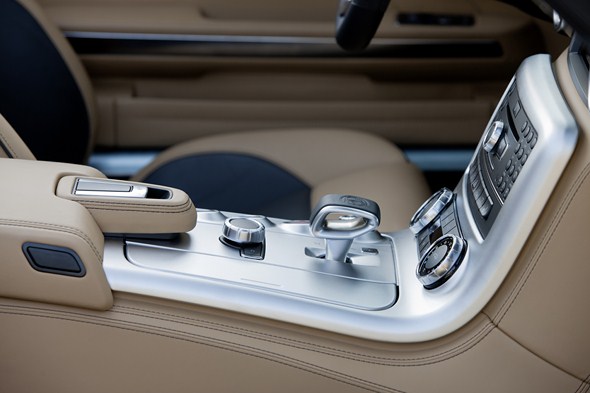
Interior and appointments
Functional, exclusive and extensive
- Fine designo leather and COMAND APS as standard
- AIRSCARF® extends the roadster season if required
- Bang & Olufsen BeoSound AMG as an optional extra
A super-sports car and cruiser in one: whether with the soft top open or closed, the SLS AMG Roadster offers its occupants an unrivalled driving experience. This is in large part due to the functional interior and extensive, exclusive standard appointments.
The driver of the SLS AMG Roadster has a low seating position typical of a sports car just 368 millimetres above the road surface. In combination with the generous effective headroom of max. 982 millimetres and the effective legroom of 1058 (driver) and 1078 (passenger) millimetres, this results in a very relaxed seating position. Good all-round visibility is made possible by the relatively upright angle of the windscreen. Decisive factors for the impression of spaciousness include the generous shoulder-room of 1483 millimetres and an elbow width of no less than 1606 millimetres.
The sports seats with integrated head restraints feature so-called two-zone seat cushions. Prominent side bolsters with a harder foam filling provide optimal lateral support, while the inner areas of the seat cushion and backrest are softer for a high level of comfort on long journeys. A black designo leather interior is standard equipment. The seat backrests are made from magnesium, a high-tech material that combines light weight with high strength. This leads to significant advantages where weight distribution and a low centre of gravity are concerned.
The fore-and-aft position, height, backrest angle, seat cushion angle and steering column are adjusted mechanically. If the optional Memory package
is specified, these adjustments including the seat cushion angle are electric; three individual seat settings can also be stored in this way. The Memory package also includes four-way lumbar supports and adjustable seat side bolsters for more lateral support when cornering at speed. Pivoting air vents are integrated into the head restraints if the optional AIRSCARF® system is specified. The airflow can be adjusted to different body sizes using movable louvres, and the heating level can be set in three stages by pressing a button. The head and neck areas of the occupants are then bathed in a warm airflow – extending the roadster season. AIRSCARF® is operated using two keys in the centre console.
Glass draught-stop as standard
Irritating turbulences are prevented by the standard glass draught-stop: this is slotted onto the bulkhead between the seats and fixed in place with two levers. When not in use, the draught-stop is securely stowed in a textile bag in the boot. In combination with the optional single or two-tone designo Exclusive leather or designo Exclusive natural/textured leather in light brown, the SLS AMG Roadster features leather-lined roll-over bars with integrated grilles which improve occupant comfort even further.
AMG Performance steering wheel with high-quality, solid metal insert
The adjustment range of the Performance steering wheel is 60 millimetres axially and 2.3 degrees either up or down – this applies to both manual and electric adjustment. The steering wheel is lined in perforated leather in the specially formed grip area, and has a high-quality, solid metal insert and a rim with a diameter of 370 millimetres, with a flattened profile in the lower section. The best possible vehicle control is not least ensured by the specially formed steering wheel cross-section. A Performance steering wheel with leather/Alcantara inserts is available as an option.
The seven gears of the dual clutch transmission are shifted using solid metal shift paddles. A brief pull on the left (–) or right (+) shift paddle is enough to engage the required gear. Multifunction keys in the left and right steering wheel spokes provide rapid access to the audio, telephone and navigation functions, and to the LINGUATRONIC voice-operated control system. The main menu in the instrument cluster can also be accessed using the ergonomically shaped steering wheel keys.
Numerous instruments and AMG main menu
Two dial instruments provide information about the vehicle speed and engine speed, and have two small, integrated displays showing the fuel level and the engine oil temperature. When the ignition is switched on, the needles of the rev counter and speedometer simultaneously spin around to their maximum position, then instantly return to zero. Between the dial instruments there is
a central display for information such as the odometer reading, range, fuel consumption, trip mileage, driving time and average speed.
The AMG main menu not only shows the individual tyre pressures at each wheel, but also has three modes for comprehensive driver information:
“Warm Up”, “Set Up” and “RACE”. “Warm Up” shows the engine oil, coolant and transmission oil temperatures, while “Set Up” shows the current ESP® mode. “RACE” makes the RACETIMER available, with which the driver is able to measure lap times on a closed race circuit. Customers opting for AMG Performance Media (optional) will not find the above functions in the AMG main menu, but rather in the display of the standard COMAND APS multimedia system.
Permanently displayed information includes the currently selected gear and the activated driving mode of the dual clutch transmission – plus the time of day, ambient temperature and digital speed. Information on the navigation system, audio functions and telephone, individual vehicle settings and the ASSYST PLUS service interval display can be accessed in the central display. The gearshift indicator is located above the display, and therefore ideally in the driver’s field
of vision: seven LEDs coloured white, yellow and red indicate the necessary gearshift if the driver of the SLS AMG has selected the manual (M) transmission mode. The faster the engine speed approaches the maximum of 7200 rpm, the more LEDs light up.
COMAND APS with DVD player as standard equipment
The centre console is also designed with the best possible ergonomics in mind. The upper section has an array of keys for the COMAND APS multimedia system. All the functions of the radio, DVD player, telephone and navigation system can be controlled from here. When switched on, the TFT colour display in the dashboard shows the unmistakable AMG logo for ten seconds – and depending on the function, a high-resolution map or other information such as the radio station, music track or telephone keypad. The Europe-wide navigation system has a 40-gigabyte hard disc on which the navigation data are stored, which means that route calculation is extremely rapid.
The car radio with integrated CD/DVD player features an FM/MW/SW and LW twin tuner with automatic station search, RDS, a 4 x 25 watt amplifier and a total of 6 loudspeakers. In addition, COMAND APS includes a music server with a memory capacity of 6 gigabytes, which enables the driver to store up to 1500 music files. A DVD player for video and audio is also on board, and an integrated 6-disc DVD changer is available on request. Below the DVD aperture the unit has an adapter that enables various PC memory cards for the reproduction of music files to be used. External audio devices such as an
“iPod” can be connected to COMAND APS via the optional Media Interface.
As a standard feature, Mercedes-Benz combines COMAND APS with the LINGUATRONIC voice-operated control system and the Bluetooth interface, which provides a wireless connection between the mobile phone and the hands-free system.
AMG DRIVE UNIT with E-SELECT lever
One of the visual and functional highlights in the interior of the SLS AMG is the solid centre console, which immediately calls an aircraft cockpit to mind. All the central control functions including the AMG DRIVE UNIT, which is inclined towards the driver, are grouped on this striking, solid-metal feature also optionally available in genuine carbon-fibre. The AMG E-SELECT shift lever with embossed AMG emblem for the AMG SPEEDSHIFT DCT 7-speed sports transmission also has a jet aircraft look: the one-touch drive-by-wire system enables the driver to shift between R, N and D extremely rapidly. When the car is stationary, simply pressing the P-key activates the parking position – this also happens automatically when the engine is switched off. To the left are the rotary controls for the transmission’s driving modes, including RACE START, as well as the keys for the ESP® functions, the extendable rear aerofoil, the AMG RIDE CONTROL sports suspension and the AMG memory function.
The engine start button is also integrated into the AMG DRIVE UNIT: this
lights up in red when the vehicle is unlocked. When the button is pressed,
the “Engine Start Stop” flashes during the starting process.
The Controller directly integrated into the centre console operates the mutimedia system COMAND APS. This rotary/push control can be moved in seven directions: turning the controller selects the main menu and submenus on the display, while pushing it activates or confirms the displayed function or setting. The buttons next to the Controller marked with “R” and “C” symbols are used to quit submenus quickly or delete entries.
Optional Bang & Olufsen BeoSound AMG surround sound system
The new sound system realised by Mercedes-Benz and AMG together with the famous Danish audio specialist Bang & Olufsen was developed specifically for the SLS AMG Roadster. The Bang & Olufsen BeoSound surround-sound system with Dolby Digital 5.1 provides an exclusive listening experience at the highest level. This is not only thanks to the amplifier with a total output of 1000 watts and
11 loudspeakers, but also to the sound processor’s precise distribution of the music signals to selectable driver, passenger or central positions. The digital sound processor (DSP) also makes it possible to choose between a high-end studio sound (“Reference”) and surround-sound. All the functions are controlled via a special Bang & Olufsen menu in COMAND APS. Particular highlights are provided by two illuminated 50-watt lens tweeters on the dashboard. As a Roadster-specific feature, a 250-watt subwoofer is integrated into the aluminium cross-member behind the seats. High-quality loudspeaker covers bearing the Bang & Olufsen logo indicate the exceptional status of this high-end system.
THERMOTRONIC comfort automatic climate control as standard
The sophisticated THERMOTRONIC two-zone luxury automatic climate control system is included as standard for outstanding climatic comfort. A powerful air conditioning compressor ensures rapid cooling of the interior; the cooled air flows from the four multi-adjustable vents in the dashboard, two apertures in the A-pillars, three at the windscreen and one in each footwell. Sensors constantly monitor the interior temperature, the temperature of the air flowing from the air vents, the air moisture content and the intensity and angle of the sun. A pollutant sensor recognises excessive carbon monoxide and nitrogen oxide concentrations in the outside air, and automatically closes the air recirculation flap if levels of these pollutants increase rapidly. A key with an Off symbol switches THERMOTRONIC off if required – for example if it is not needed because the soft top is open.
The modern, short-travel control keys in the SLS AMG require an operating force of only four newtons. All keys and switches are treated with Softtouch paint, which creates a silky sheen and a soft surface. The homogeneous, amber-coloured illumination of the control symbols ensures easy recognition, and also underlines the high-quality appearance of the interior when driving at night.
A wealth of stowage spaces for typical Mercedes day-to-day suitability
The interior also impresses with practically designed stowage facilities for
typical Mercedes day-to-day suitability. The glove compartment with a capacity
of 3.7 litres and a spectacles compartment is in the dashboard on the passenger side. To the right of the E-SELECT lever there is a small compartment with a
12 V socket or on request an ashtray with cigar-lighter. The armrest behind the centre console not only facilitates operation of the COMAND Controller, as it also has the conveniently integrated control switch for the electrically operated fabric soft top.
The armrest can be moved in two stages at the touch of a button, revealing a stowage compartment in which there are two cupholders and a telephone cradle (optional). Other items can be stowed in compartments in the doors, the stowage system on the rear bulkhead between the seats and the map pocket in the passenger footwell. Two clothes hooks are attached to the seat backrests. The unlocking switch for the boot lid is located below the light switch in the dashboard. Alternatively the boot can also be opened using the button in the vehicle key. The boot has a capacity of 173 litres (acc. to VDA measuring method).
Overview of the comprehensive standard equipment (selection):
- AMG sports seats with three-stage seat heating
- COMAND APS
- Floor mats with AMG logo
- Interior in black designo leather
- Anti-theft alarm system with tow-away protection
and interior monitoring - Electric parking brake
- Headlamp Assist
- KEYLESS-GO start function
- PARKTRONIC
- Rain sensor
- Tyre pressure monitoring system
- Child seat recognition in the passenger seat
- Sports pedals in brushed stainless steel with rubber studs
- Cruise control with SPEEDTRONIC
- THERMOTRONIC
Optional extras include the following (extract):
- AMG alubeam silver
- AMG Le Mans red
- AMG Monza grey Magno
- AMG Sepang brown
- designo magno alanite grey
- designo mystic white 2
- 6-disc DVD changer
- AIRSCARF®
- Bang & Olufsen BeoSound AMG surround sound system
- Interior appointments in designo single-tone Exclusive leather
- Interior appointments in designo two-tone Exclusive leather
- Interior appointments in designo Exclusive light brown natural leather/embossed leather
- Automatically dimming interior mirror and exterior mirror on driver’s side, as well as electrically folding exterior mirrors left and right with ambient lighting
- Media interface
- Memory package with electric seat and steering column adjustment,
as well as a four-way lumbar support - Blind Spot Assist
Even more individuality is possible with optional extras from the AMG Performance Studio:
- AMG carbon-fibre exterior mirrors
- AMG carbon-fibre engine compartment cover
- AMG Interior Carbon Fibre package (carbon-fibre trim, trim on seat backrest and side, door sill panels)
- AMG ceramic high-performance composite braking system
- AMG light-alloy wheels in a 5-twin-spoke design, painted in titanium grey with high-sheen finish, size 9.5 x 19 inches (front) and 11.0 x 20 inches (rear), tyre sizes 265/35 R 19 (front) and 295/30 R 20 (rear)
- AMG Performance steering wheel in leather/Alcantara®
- AMG Performance Media
- AMG RIDE CONTROL sports suspension with adaptive damper adjustment
- AMG forged wheels in a 10-spoke design, painted in titanium grey and polished, size 9.5 x 19 inches (front) and 11.0 x 20 inches (rear), with tyre sizes 265/35 R 19 (front) and 295/30 R 20 (rear)
- AMG forged wheels in a 10-spoke design, painted in matt black with high-sheen finish, size 9.5 x 19 inches (front) and 11.0 x 20 inches (rear), with tyre sizes 265/35 R 19 (front) and 295/30 R 20 (rear)
- AMG carbon-fibre trim
- AMG high-gloss black trim
- Red-painted brake calipers
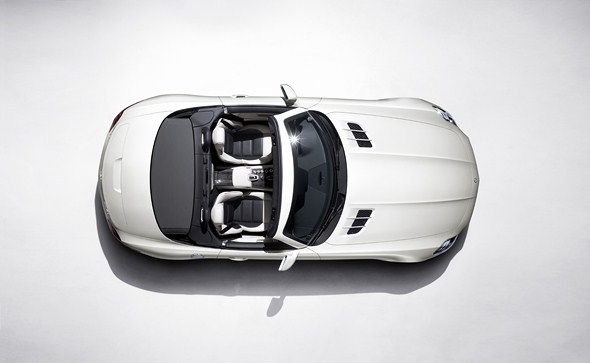
AMG Performance Media
Internet plus telemetrics as in motor racing
- Lateral and linear acceleration data as in Formula 1
- Display of engine output, torque and accelerator position
- Storage and recording function for personal analyses
- Integration of RACE START mode
- High-speed internet connectivity as with a smartphone
- System uses the high-resolution colour display of COMAND APS
Informative, distinctive and unique: the new AMG Performance Media combines numerous telemetric displays such as various engine data, lateral and linear acceleration, lap times with high-speed mobile internet connectivity. Many of the functions of AMG Performance Media were inspired by motor racing. This outstanding optional system developed by Mercedes-AMG is celebrating its debut in the SLS AMG Roadster and Coupé, and will also
be a feature of other AMG high-performance cars in the future.
Key functions at a glance:
- Real-time display of lateral and linear acceleration combined with braking performance and accelerator position, including memory function
- Recording of individual lap times on a closed-off racetrack, with sector times and memory function
- Integration of Drive Unit functions to save setup data to memory and initiate RACE START
- Real-time display of acceleration time from 0-100 km/h (alternatively: quarter-mile)
- Real-time display of engine oil, coolant and transmission fluid temperature
- Real-time display of engine output, torque and accelerator position
- Real-time display of individual tyre pressures
AMG Performance Media is activated by pressing the AMG key in the AMG DRIVE UNIT, and operated with the COMAND Controller. All functions are visible on the high-resolution 17.8-centimetre colour display of the standard COMAND APS multimedia system. Numerous items of information which are otherwise integrated into the AMG menu in the central display are now to be found in graphic form in AMG Performance Media – e.g. the tyre pressure display, the active transmission mode, the ESP® mode, the suspension setup and the engine oil/coolant/transmission oil temperatures.
The upper menu bar offers a choice of “Data”, “Race” and “Setup”, while the lower bar offers further choices such as “Temp”, “Power” and “Tyres”. When the desired sub-menu has been selected, the menu bars disappear and the display fills the entire screen. Three displays always appear at the same time, the most important information being displayed in the centre. Simulated digital dial instrument with red needles ensure outstanding legibility. The vehicle is configured using the “Setup” menu – storing e.g. the transmission mode or the ESP® mode: the active setup appears on the left, an individually configurable setup in the centre and RACE START mode on the right.
Real-time “Power” display: engine output and torque
Sheer excitement is guaranteed by the “Power” display: depending on the accelerator position shown on the right, the central dial instrument shows the current engine output in hp while the scale on the left indicates the current torque in newton metres – in this way AMG Performance Media delivers full, visual proof of the high performance of which the SLS AMG Roadster is capable. In the “Temp” menu the engine oil temperature is shown in the centre, flanked by the coolant temperature (left) and the transmission oil temperature (right). The tyre pressure display shows a stylised SLS AMG and the respective tyre pressures.
“Race” mode: G-Meter visualises high driving dynamics
In “Race” mode the so-called G-Meter appears in the centre, showing the driver the current lateral and linear acceleration. The left and right displays show
the current brake pressure and the accelerator position, each as a percentage. The G-Meter enables the driver to monitor the high driving dynamics of the SLS AMG Roadster. Depending on the driving situation, the red dot moves forwards, backwards, to the left or right. Three circles in the dial instrument show a graduation of the current G-forces from 0.5 g and 1.0 g to 1.5 g. Motorsport fans will be familiar with this display from TV reporting of Formula 1 events.
A grey bar shows the maximum acceleration rates achieved since the last reset. In the “History” function the driver can call up a display of the lateral and linear acceleration figures for the last ten minutes. The time of day, steering angle in degrees and vehicle speed are also stored in memory. A screenshot showing the figures is also available, and this can be saved to
an external memory via a USB interface.
“Track” menu: personal race engineer on board
An even greater motor sports feeling is provided by the “Track” menu. This mode not only offers various recording possibilities, for example individual lap times on a closed race circuit, but also sector times including an analysis and memory function. In short: “Track” mode places a personal race engineer on board the SLS AMG Roadster, who is able to help the competitive driver to make continuous improvements to their personal racetrack performance.
Not only the respective lap times are therefore displayed, but also the difference from the fastest lap time. And this is not all: all individual figures such as brake pressure, accelerator position, lateral and linear acceleration can be separately displayed for each lap when in Parameter mode. In conjunction with the individually selectable sector times, the driver is able to see at a glance where his improvement potentials lie.
The matrix display allows up to five laps to be compared. AMG Performance Media saves the absolved racing laps to memory. The driver is able to decide which laps to display. The fastest lap time is shown in green, and the best and worst individual figures in green and red respectively.
The relevant circuit layout is shown graphically, with the Nürburgring North Loop and Hockenheimring in Baden-Württemberg integrated ex factory. New circuits can be individually absolved, named and stored in memory. Lap times and data recorded in Track mode can be saved to a USB stick, enabling the data to be reloaded into the system at a later time, or analysed on the PC at home.
RACE START mode: faster and more convenient than before
RACE START mode is a further function, and its activation is faster and more convenient in conjunction with AMG Performance Media. After selection using the COMAND Controller, a bar chart shows the driver the necessary braking pressure. The driver then only needs to pull the shift paddle in the “Up” direction once to confirm the RACE START function, fully depress the accelerator and release the brakes. Manual pre-selection using the rotary transmission control is unnecessary, as is activation of ESP® SPORT Handling mode.
High-speed mobile internet access
In addition to all the telemetric displays derived from motor sports, AMG Performance Media provides fully-fledged, mobile high-speed internet access: when the car is stationary, the driver and passenger are able to surf the web and install apps. This unique system therefore offers functions similar to
those of a smartphone. AMG Performance Media uses the widely used,
highly capable Android operating system. Depending on availability, AMG Performance Media uses HSDPA/UMTS and EDGE/GPRS as data services. The precondition for the internet functions is a mobile phone contract with a data option. Internet navigation is via the COMAND Controller, which also allows a cursor mode. No internet sites can be displayed while the car is on the move.
InCar hotspot with WLAN function
The InCar hotspot is yet another function: WLAN-capable devices such as netbooks, laptops, smartphones or MP3 players can be connected to AMG Performance Media to allow wireless internet surfing – also of course while
on the move in the passenger’s case. Connection of the device is fast and convenient, as with the Bluetooth function.
Install and use apps during a journey
AMG Performance Media also allows apps to be installed, with access using the menu item “Apps”. For installation, apps can be downloaded from the internet via the system browser or alternatively using a computer. For this purpose the system has an interface housed in the glove compartment to which a USB
stick can be connected. Use of the apps is possible while on the move if
the predefined Drive Mode is supported. Apps which do not allow vehicle-compatible display are hidden when the car is on the move. There is audio reproduction in the background.
